Looking for some inspiration for your container gardening project? Whether you are planning on using the popular Trough Planter Box, Cube Pot, or Round Planters, we have some inspiring ideas here for you. If fact, we have gathered 125 container garden ideas and tips so grab a cuppa and read on to treat yourself to these awesome ideas.
For a deeper dive into the core principles of Container Gardening Landscape Design, check out our Garden Pots and Planter Boxes Landscape Design Ideas Guide.
1. Highlighting Doorways with Container Planting
Emphasising a doorway through container gardening featuring tall topiary plants can significantly enhance the aesthetic appeal of your home or office. These elegant, sculptural plants not only frame the entrance beautifully but also create a warm and inviting atmosphere for visitors. By incorporating container planting, you add a touch of greenery that softens the architectural lines, making the space feel more welcoming and visually appealing throughout the seasons.
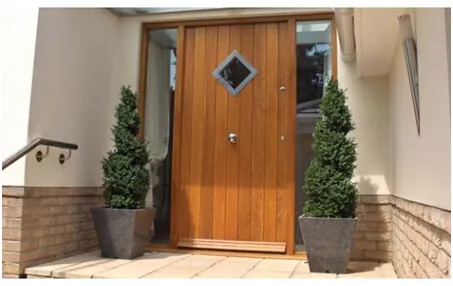
2. Prevent Structural Damage by Putting Small Trees in Strong Pots
The vigorous root growth of small trees can potentially cause significant structural damage to paving, driveways, or swimming pools. To prevent such issues, it’s essential to plan ahead and place these trees in large, durable containers that can effectively accommodate their root systems. By using robust pots, you can manage the growth of the roots while also enhancing the aesthetic appeal of your outdoor space, ensuring that both your landscape and structures remain intact and visually pleasing.
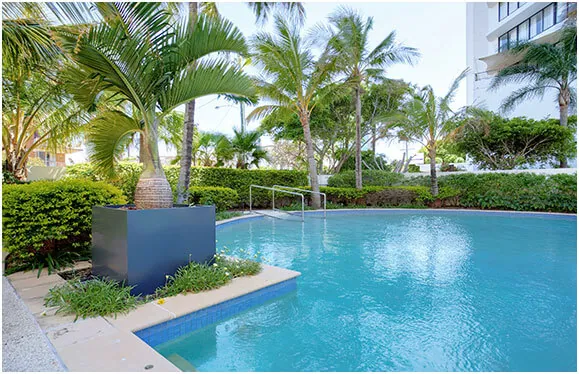
3. Consider the Plant’s Mature Size When Planting
When selecting plants for your container garden, it’s crucial to consider their mature size to ensure a harmonious design. Choosing plants that will grow too large can overshadow other visual elements in your arrangement, disrupting the intended aesthetic. By researching and understanding the eventual height and spread of each plant, you can create a balanced and visually appealing display. This foresight not only maintains the beauty of your garden but also ensures that each plant has adequate space to thrive without overcrowding its neighbours.
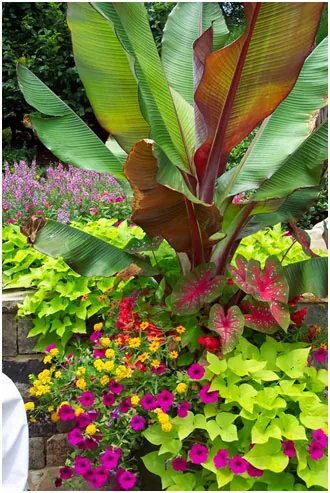
4. Linear Repetition Using Same Size Pots
Creating a visually striking display with plant pots of the same size can be achieved through linear repetition. By selecting a few pots filled with vibrant, colourful foliage and arranging them in a straight line, you can establish an attractive barrier or a stunning alternative to traditional fencing. This approach not only enhances the aesthetic appeal of your outdoor space but also adds a sense of order and cohesion to your garden design. Additionally, this linear arrangement can serve as a decorative embellishment, drawing attention to pathways or specific areas of your landscape while providing a delightful contrast to other design elements.
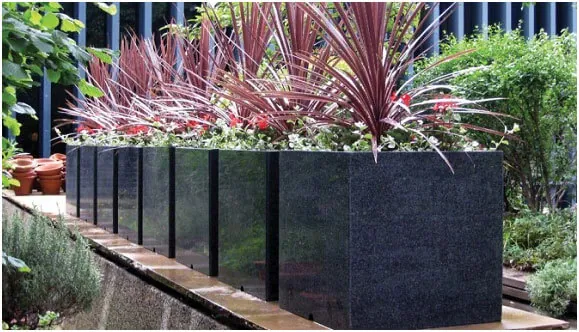
5. Use Thrillers, Fillers and Spillers in a Container
In container gardening, incorporating a combination of “thrillers,” “fillers,” and “spillers” creates a dynamic and visually appealing arrangement. Thrillers are the standout plants that provide height and drama, drawing the eye upward and serving as the focal point of the display. Fillers are medium-height plants that fill in the gaps and add volume, ensuring the arrangement looks lush and full. Lastly, spillers are trailing plants that cascade over the edges of the pot, softening the overall look and creating a beautiful flow. By thoughtfully combining these three types of plants, you can achieve a well-balanced container garden that is both stunning and harmonious.
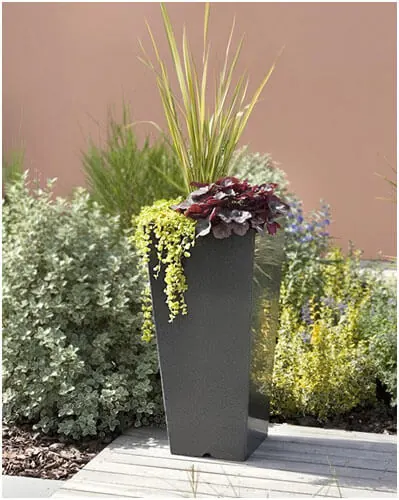
Image from http://www.houzz.com/ideabooks/37117/list/Cape-Cod-Window-Boxes-Container-Designs+
6. Use Rectangular Pots to Guide Pedestrian
Utilising rectangular plant containers in public spaces is an effective way to guide pedestrian traffic while enhancing the overall aesthetic. These pots can be strategically placed to create clear pathways, encouraging movement in a desired direction. For durability and style, granite pots are highly recommended, as they can withstand the rigours of high-traffic commercial areas. Their robust nature ensures that they remain intact and visually appealing over time, making them an ideal choice for outdoor environments. By incorporating these containers, you not only improve navigation but also add a touch of elegance to the landscape, contributing to a more organised and inviting public space.
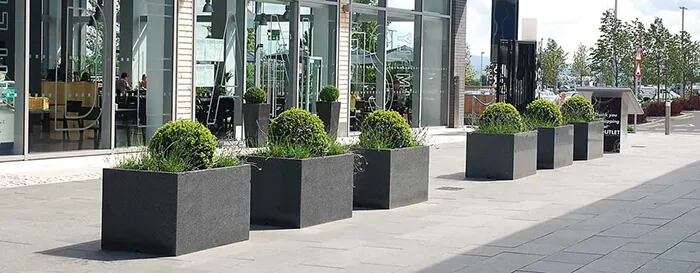
7. Liven Up Boring Corners with Container Garden Ideas
If you find a section of your design looking dull or uninspired, consider livening it up with some thoughtfully placed container gardens. Adding a few tall pots filled with vibrant plants can instantly transform an uninspiring corner into a focal point of interest. The height of the pots draws the eye upward, creating visual intrigue without overwhelming the space. Choose a mix of colourful foliage or flowering plants that complement the surrounding elements, ensuring a harmonious look. This simple yet effective approach not only eliminates the monotony but also enhances the overall aesthetic of your garden or outdoor area, making it feel more inviting and lively.
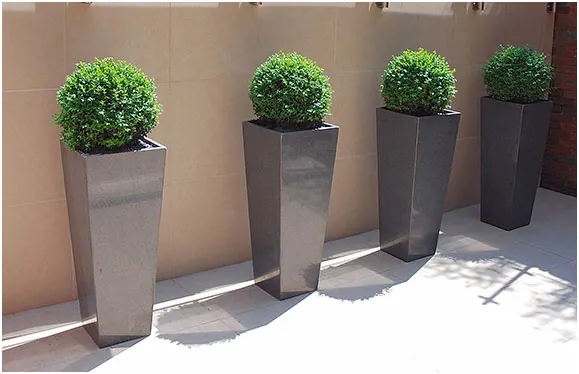
8. Workplace Container Planting Comes with Many Benefits
If you find a section of your design looking dull or uninspired, consider livening it up with some thoughtfully placed container gardens. Adding a few tall pots filled with vibrant plants can instantly transform an uninspiring corner into a focal point of interest. The height of the pots draws the eye upward, creating visual intrigue without overwhelming the space. Choose a mix of colourful foliage or flowering plants that complement the surrounding elements, ensuring a harmonious look. This simple yet effective approach not only eliminates the monotony but also enhances the overall aesthetic of your garden or outdoor area, making it feel more inviting and lively.
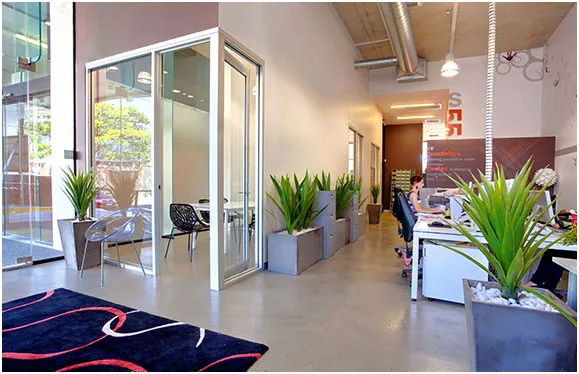
9. Indoor Container Planting – Seal Those Drain Holes
When engaging in indoor container planting, it’s essential to consider how to manage excess water effectively. One practical solution is to seal the container’s drain holes to prevent any mess during watering. This approach allows you to maintain a clean environment, as it prevents water from leaking onto surfaces and creating unsightly spills. For professional environments consider a Drip Irrigation System
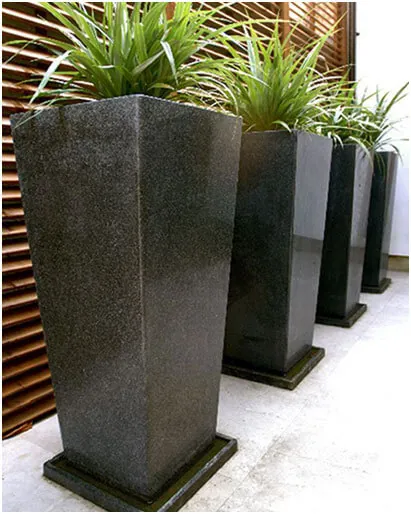
10. Use High Quality Frost-Resistant Containers
According to BBC Gardener of the Decade Katherine Crouch, high-quality frost-resistant pots are the best investments for a great garden. Frost-resistant planters are essential for keeping plants thriving during chilly months. Cheaper containers, often made of materials like terracotta or glazed ceramics, may not withstand freezing temperatures as well as concrete or fiberglass. To protect roots from harsh winter conditions, consider adding a layer of insulation like bubble wrap or newspaper to the planter’s interior. With proper care, frost-resistant planters can ensure your plants flourish even in the dead of winter.
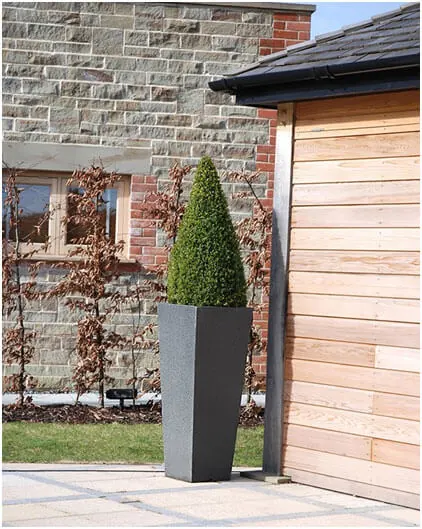
11. Succulents Require Drainage
Succulents are drought-tolerant plants that thrive in well-draining soil. Overwatering is a common cause of succulent death, so it’s essential to ensure your pot has adequate drainage. Drain holes allow excess water to escape, preventing root rot. If your pot lacks drain holes, consider adding a layer of pebbles or gravel to the bottom to improve drainage. These materials create a barrier that allows water to pass through while preventing the soil from becoming waterlogged.
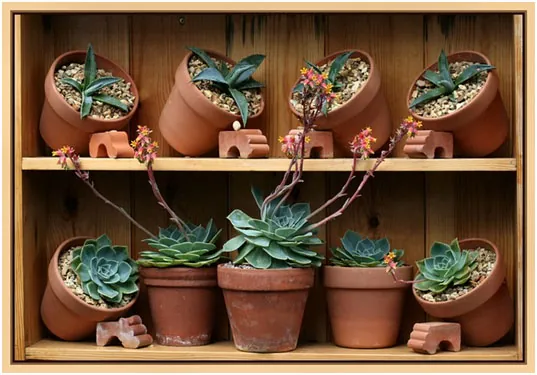
12. Be Generous with Succulents
Why plant just one succulent in a pot when you can plant a bunch of them? Succulents are versatile plants that can be combined in countless ways to create stunning arrangements. Instead of planting just one succulent in a pot, consider grouping multiple varieties together for a more visually appealing and dynamic display. The contrasting shapes, textures, and colors of different succulents can complement each other beautifully. Experiment with various combinations to find your favourite and unleash your creativity.
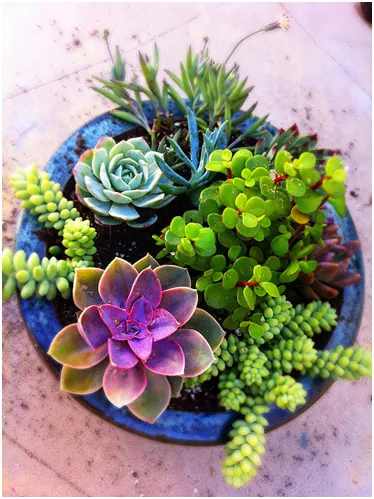
Image from http://www.luna-see.com/2012/05/diy-mixed-potted-succulent-garden.html
13. Fishbowl Succulents
Whoever said fishbowls are just for fish? Repurpose a fishbowl for a unique succulent arrangement. Fill it with well-draining soil and plant a variety of succulents that thrive in bright, indirect light. Water sparingly, as succulents are drought-tolerant. Enjoy the low-maintenance beauty of your fishbowl garden. Plant a variety of succulents in there and watch them thrive with very little maintenance on your end. This makes for a good table-top plant.
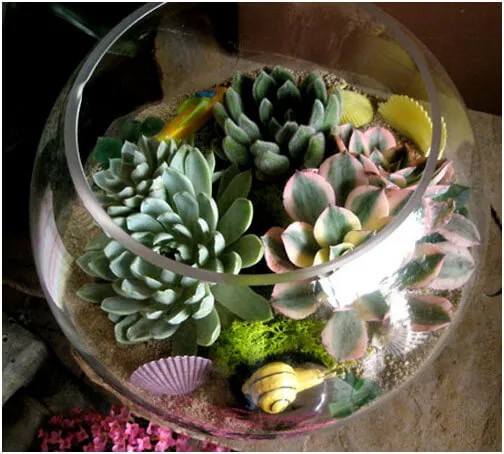
Image from http://thecottagemarket.com/2013/05/stunning-succulent-gardens.html
14. Not Enough Space? Hang Your Plants
If you’re running out of room on your patio or balcony, consider hanging your plants. This creative approach can maximise your space and add a unique touch to your outdoor decor. There are a variety of hanging planters available, from macrame baskets to metal cages. Choose plants that are suitable for hanging, such as trailing varieties or those with compact growth habits. With a little imagination, you can create a beautiful and functional vertical garden that will enhance your outdoor living space.
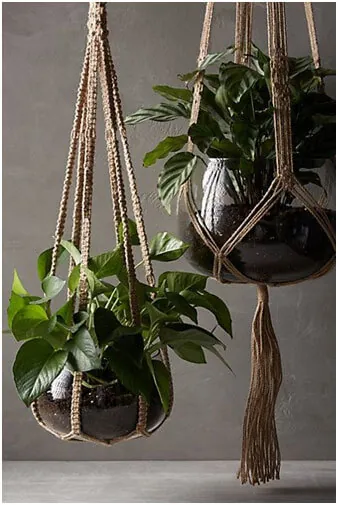
15. Create a Vertical Garden using an Old Pallet
Repurpose an old wooden pallet into a stylish vertical garden. Clean and sand the pallet to prepare it for planting. Drill holes in the spaces between the slats to accommodate small plant pots. Fill the pots with well-draining soil and plant your favourite succulents, herbs, or flowering plants. Secure the pots to the pallet using zip ties or twine. Hang the pallet on a wall or lean it against a fence to create a unique and space-saving vertical garden.
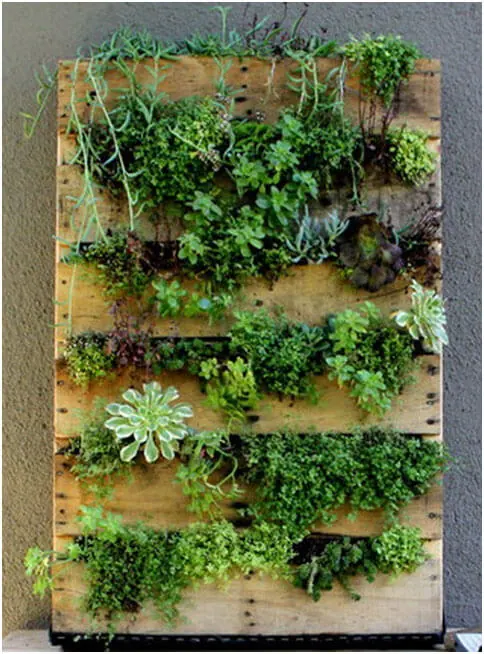
Image Credit: http://removeandreplace.com/2013/03/18/pallet-gardens-10-amazing-garden-pallets-and-tips-how-to-get-started/
16. Mosquito Problems? Plant Lavender – Nature’s Mosquito Repellent
Lavender is more than just a fragrant herb; it’s a natural mosquito deterrent. The plant’s strong scent is unpleasant to mosquitoes, making it an ideal choice for outdoor spaces. To ward off these pesky insects, plant lavender on your patio or balcony. Not only will you enjoy the calming aroma, but you’ll also create a more peaceful and enjoyable outdoor environment. Those afternoon naps on your patio will become a better experience.
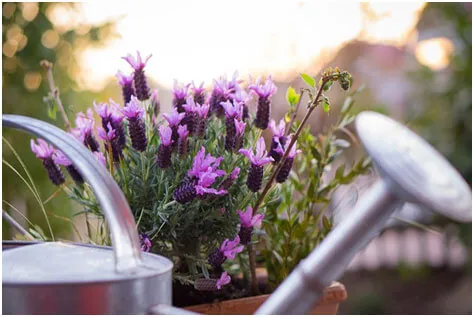
17. Rooftop Container Gardening: A Sky-High Oasis
Transform your rooftop into a lush oasis with container gardening. Choose containers with adequate drainage and select plants that thrive in your rooftop’s climate. Water regularly, fertilise as needed, and monitor for pests. Enjoy the fresh produce, beautiful flowers, and peaceful retreat your rooftop garden provides.
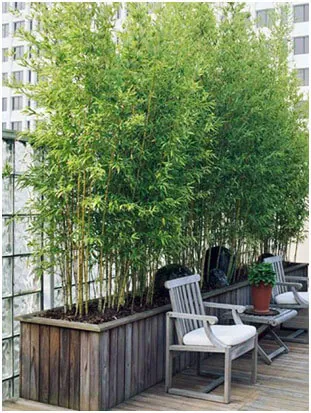
18. Avoid the Pot-Lifting Dilemma
Ever tried lifting a large pot filled with soil and plants? It’s heavy right? Before filling a large pot with soil, carefully consider its final placement. Lifting a heavy pot filled with soil and plants can be challenging and potentially damaging. To save yourself from unnecessary strain, choose a suitable location for the pot and place it there before adding soil and plants. This will prevent the need for heavy lifting and ensure a more enjoyable gardening experience.
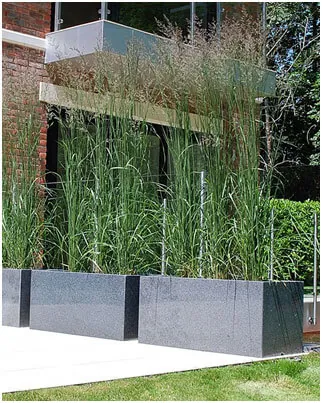
19. Water Fountain Turned Planter
Give your old water fountain a new life as a unique planter. Remove any pump or plumbing components and fill the basin with well-draining soil. Plant a variety of succulents, herbs, or flowering plants to create a beautiful and functional centrepiece. Enjoy the natural drainage provided by the fountain’s design, ensuring your plants stay healthy and hydrated.
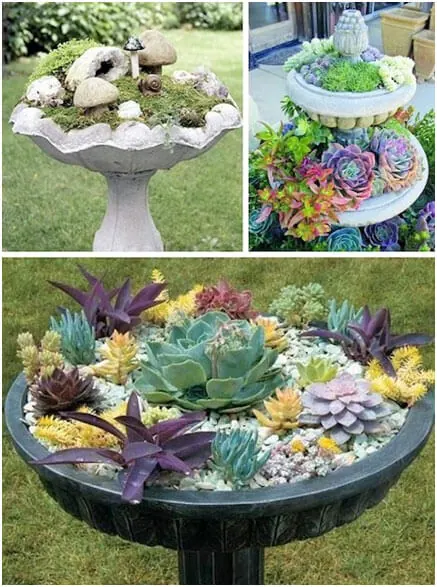
Image Credit: http://www.listotic.com/creative-garden-container-ideas/6/
20. Tree Stump Planters: A Rustic and Natural Touch
Repurpose an old tree stump into a unique and eye-catching planter. Using a chisel, carefully carve out the centre of the stump to create a hollow space for planting. Fill the cavity with well-draining soil and plant a combination of thriller, filler, and spiller plants. The rustic texture of the tree stump will provide a natural and charming backdrop for your plants, adding a touch of organic beauty to your garden or patio.
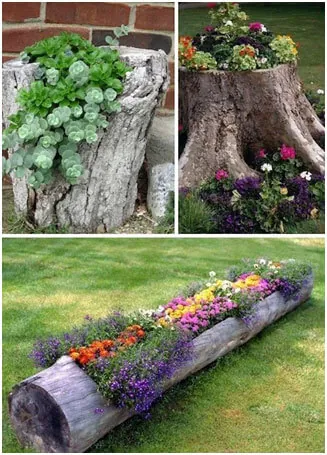
Image Credit: http://www.listotic.com/creative-garden-container-ideas/9/
21. Boat Planters
Transform an old, weathered boat into a stunning summer garden centrepiece. Fill it generously with high-quality potting mix, then plant a vibrant assortment of colourful blooms. Imagine the cheerful scene – a profusion of vibrant flowers overflowing from the sides of the boat, creating a whimsical and eye-catching focal point in your outdoor space.
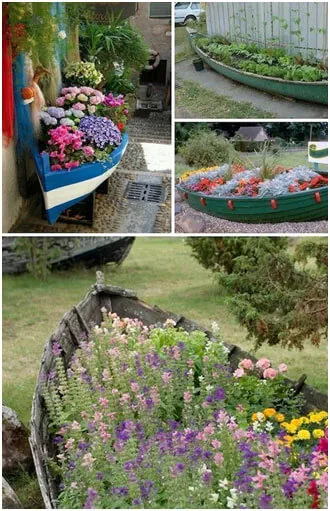
Image Credit: http://www.listotic.com/creative-garden-container-ideas/24/
22. Ornamental Grass
Ornamental grasses are a valuable asset when designing container gardens. Their inclusion adds a crucial layer of depth, transforming a potentially flat arrangement into a dynamic and visually interesting display. The varying heights of different grasses create a vertical element, while their unique textures – from feathery plumes to spiky blades – provide a captivating contrast to the leaves and blooms of other plants.
Moreover, the colours offered by ornamental grasses extend beyond the typical green, with varieties boasting hues of burgundy, gold, and even blue, further enhancing the overall aesthetic appeal. Finally, the gentle swaying motion of grasses in the breeze adds a dynamic quality to the container, creating a sense of life and movement that can truly elevate your outdoor decor.
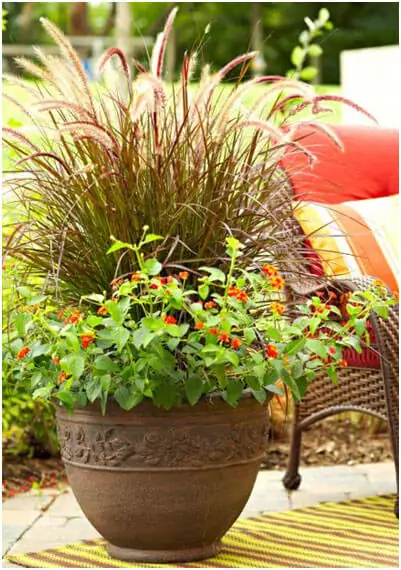
Image Credit: http://www.midwestliving.com/garden/container/container-gardens-tips/?page=4
23. Highlighting Small Plants
When incorporating small plants into your decor, consider using equally diminutive containers to maintain visual harmony. Strategically placing these arrangements at eye level ensures maximum visibility and appreciation. This approach allows the delicate beauty of the plants to shine.
However, it’s crucial to avoid the opposite scenario: pairing small plants with oversized pots or placing them in expansive spaces. This creates an awkward imbalance and diminishes the impact of the plants. By adhering to these guidelines, you can effectively showcase small plants and create visually pleasing and harmonious displays.
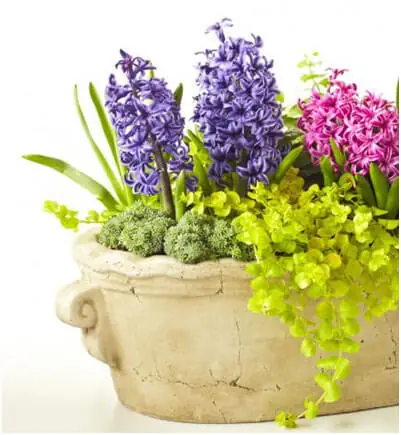
Image Credit: http://www.midwestliving.com/garden/container/container-gardens-tips/?page=13
24. Add Dimension by Going High
Introducing verticality to your garden can dramatically enhance its visual appeal. By elevating some of your most vibrant and colorful plants, you create a dynamic, multi-layered landscape. This technique not only adds visual interest but also draws the eye upwards, showcasing the beauty of your blooms from new perspectives.
Consider utilizing raised beds, trellises, obelisks, or even creative container arrangements to lift your plants off the ground. This simple yet effective strategy will transform your garden into a captivating three-dimensional masterpiece.
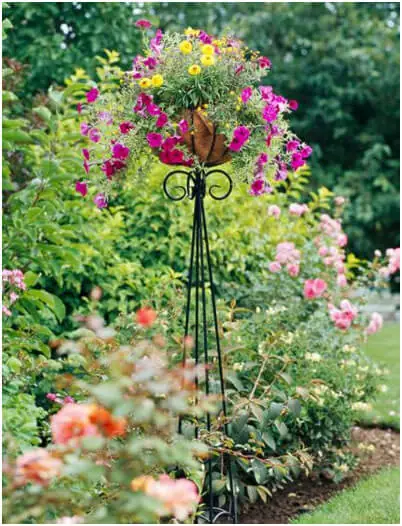
Image Credit: http://www.midwestliving.com/garden/container/container-gardens-tips/?page=14
25. Match Plants Under the Same Sun
Creating a thriving container garden requires careful consideration of your plant’s needs. One crucial factor is sunlight exposure. To ensure optimal growth and health, group together plants that share similar sun requirements. Whether they thrive in full sun, partial shade, or deep shade, consistent light conditions will prevent stress and promote vigorous growth. Furthermore, consider their water and nutrient needs.
Plants with similar watering schedules and fertiliser requirements will thrive in the same environment, minimising the risk of overwatering or under-fertilising certain plants within the container. By carefully selecting and grouping plants based on these key factors, you’ll create a harmonious and flourishing container garden that brings you joy for seasons to come.
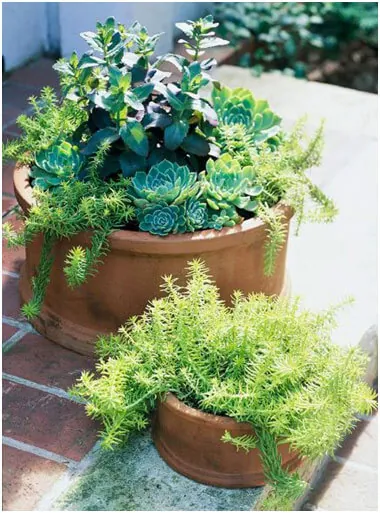
Image Credit: http://www.midwestliving.com/garden/container/container-gardens-tips/?page=18
26. Use Native Plants
For effortless container gardening, embrace the beauty of native plants. Instead of exotic species, explore the diverse array of colourful native plants thriving in your region. These resilient plants are perfectly adapted to your local climate and soil conditions, requiring minimal care and reducing the risk of unexpected losses.
By choosing native species, you not only simplify your gardening routine but also contribute to the local ecosystem by supporting pollinators and wildlife. Embrace the natural beauty of your surroundings and create vibrant container gardens that are both visually stunning and environmentally friendly.
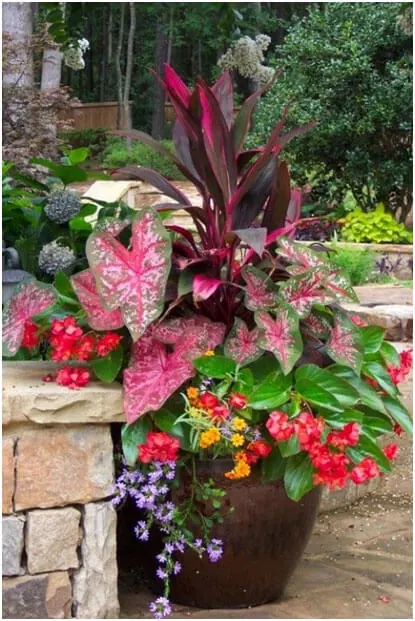
Image Credit: http://whatsurhomestory.com/lets-pack-a-punch-container-gardening/
27. Grouping Different Sized Containers
Grouping containers of varying shapes and sizes can be a visually captivating design approach. The interplay of different forms and dimensions creates a dynamic and engaging display. Whether it’s a collection of tall, slender pots juxtaposed with wide, shallow bowls, or a mix of ceramic, terracotta, and metal containers, the diversity adds visual interest and depth to your outdoor space.
This approach allows you to experiment with different arrangements, creating unique and personalised groupings that reflect your individual style.
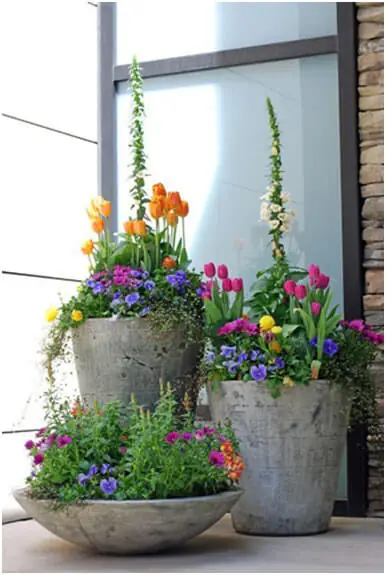
Image Credit: http://paigespartyideas.com/porch-pots/6/
28. Use Deep Dark Colours
Incorporating deep, dark colours like rich purples, deep reds, and velvety burgundies can significantly elevate your garden design. These hues add a layer of sophistication and warmth, creating a sense of richness and depth that lighter colours may lack.
They can ground a vibrant colour scheme, provide a striking contrast to lighter blooms, and even evoke a sense of mystery and intrigue. Whether used in foliage, flowers, or decorative elements, these deep, dark colours can add a touch of drama and elegance to any outdoor space.
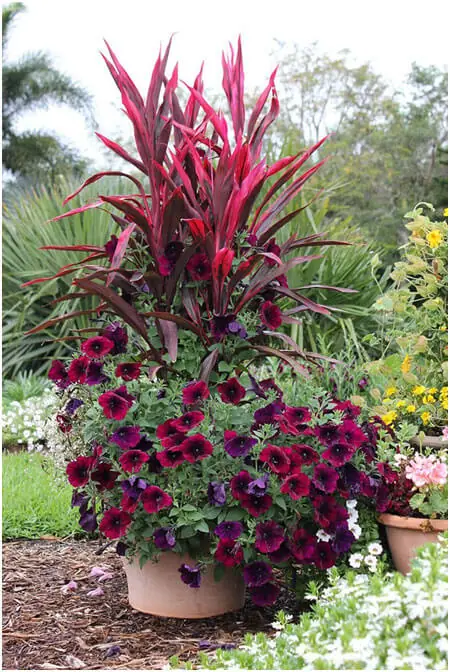
Image Credit: http://www.costafarms.com/get-growing/slideshow/container-combo-ideas-from-costa-farms
29. Vertical Wall Gardens
Vertical gardens offer a brilliant solution for those with limited space. These innovative systems maximise your growing area by utilising vertical surfaces like walls or fences. Contrary to popular belief, creating a vertical garden isn’t overly complex.
Numerous DIY and pre-made systems are available, making it accessible to gardeners of all skill levels. From simple hanging planters to intricate living walls, vertical gardens not only enhance your green space but also add a unique and visually striking element to your home or outdoor area.
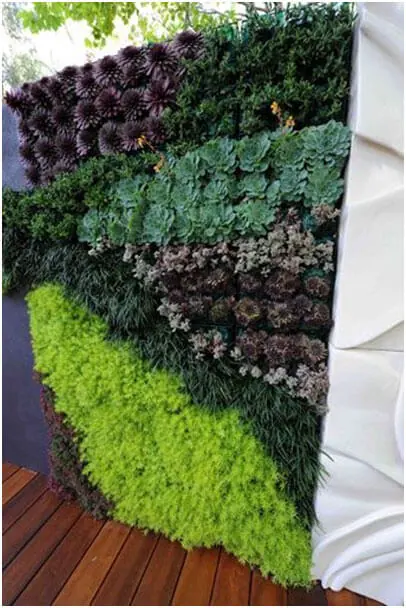
Image Credit: http://livingholmesdesign.com.au/verti-scape-green-wall-module.html
30. Make a Living Breathing Succulent Picture
Gardening is an art form, and this project allows you to create a living masterpiece. Plant a diverse array of succulents within a wide, square container. This container will serve as the frame for your “living picture,” showcasing the unique textures and colours of each succulent.
Experiment with different varieties, arranging them to create patterns, gradients, or even abstract designs. The result will be a captivating and ever-evolving piece of botanical art that adds a touch of nature’s beauty to your home or garden.
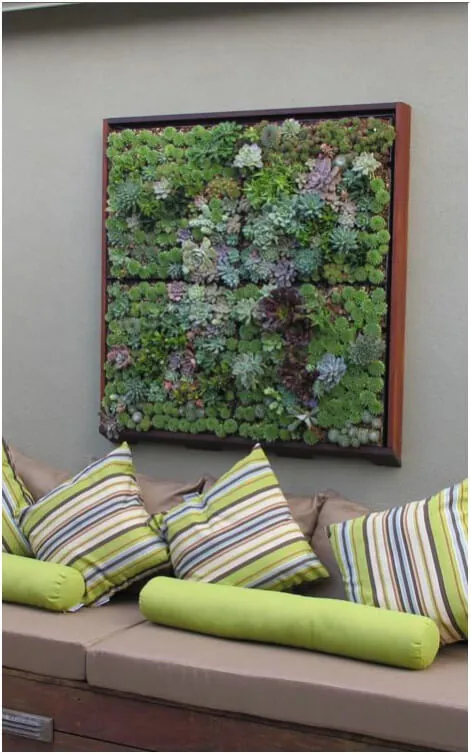
31. Place Woody Plants in Containers for More Design Options
Planting woody plants in containers allows for more design choices for patio gardens. When using containers this way, gardeners are able to use plants outside their hardiness zones.
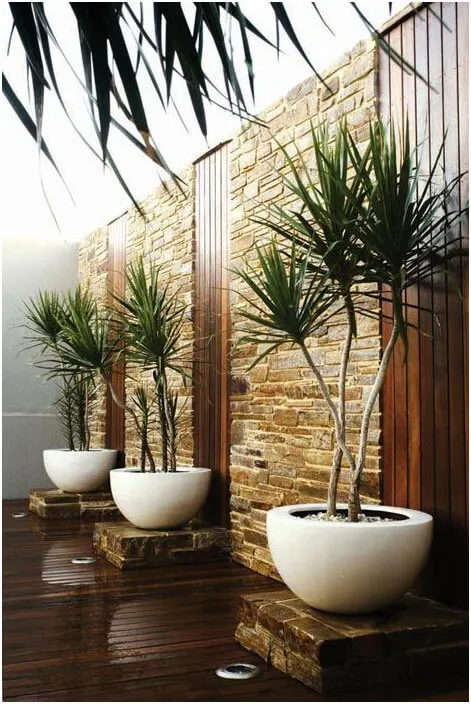
https://www.pinterest.com/pin/451626668860852274/
32. Bamboo in Containers
Give your garden an oriental feel using bamboos. It gives height and depth to your garden. Bamboo can be invasive so keeping them in containers keeps them in check.
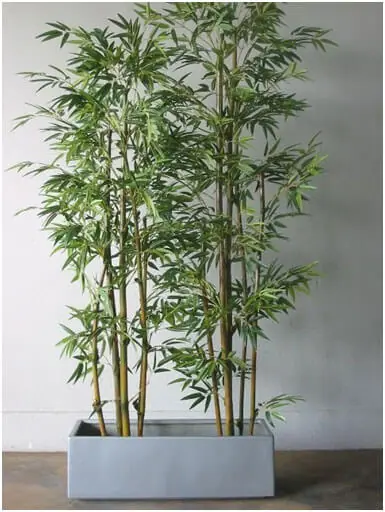
Image Credit: http://hydroponics-fine.blogspot.com/2008/01/bamboo-with-hydroponics.html
33. Overflow Bloom Effect
Tilt your container and plant your flowers in such a way that it is flowing out from the container and get this dramatic effect on your garden.
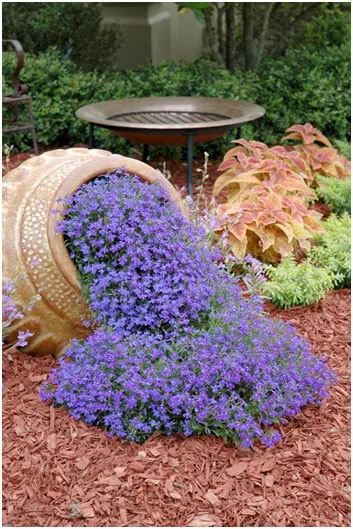
Image Credit: http://www.diyandmag.com/anyone-can-make-these-10-beautiful-and-useful-diy-accessories-for-a-garden-outdoors/6-2/
34. Spiral Garden
Create your own spiral garden using wire and a few metal rods. This makes for an attractive focal point in your garden.
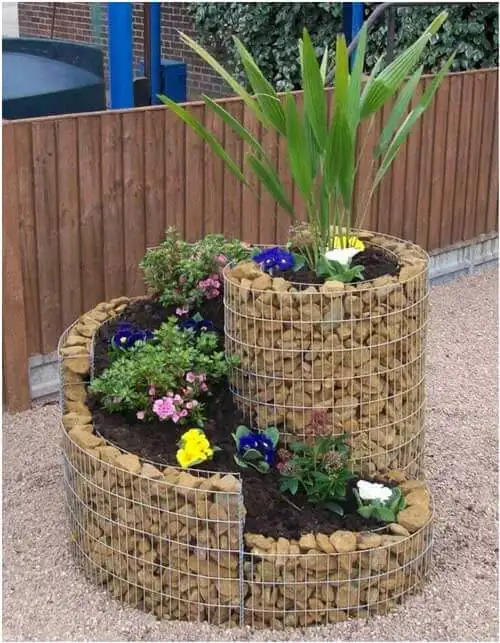
Image Credit: https://www.pinterest.com/pin/319122323572740276/
35. Glowing Flower Planters
Coat planters with glow-in-the-dark paint for instant night lighting.
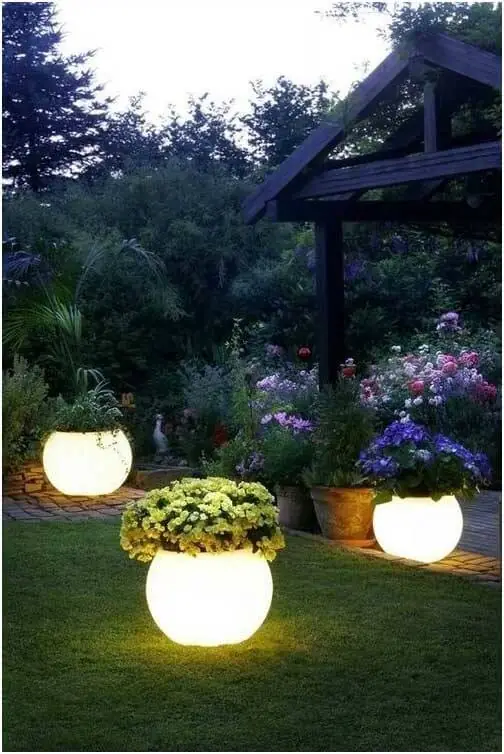
36. Vegetable Container Garden
Using your portable planter to grow vegetables is a fantastic and economical idea. Container gardening needn’t be limited to flowers and foliage.
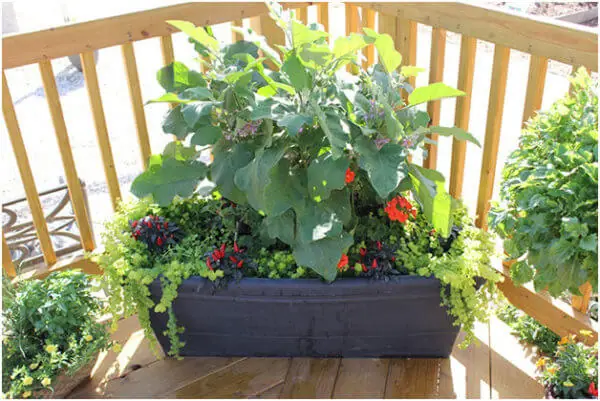
37. Jewelled Planter
Got some broken accessories? Adorn your planters with semi-valuable beads and crystals or any other sparkling accessories for a beautiful jeweled planter.
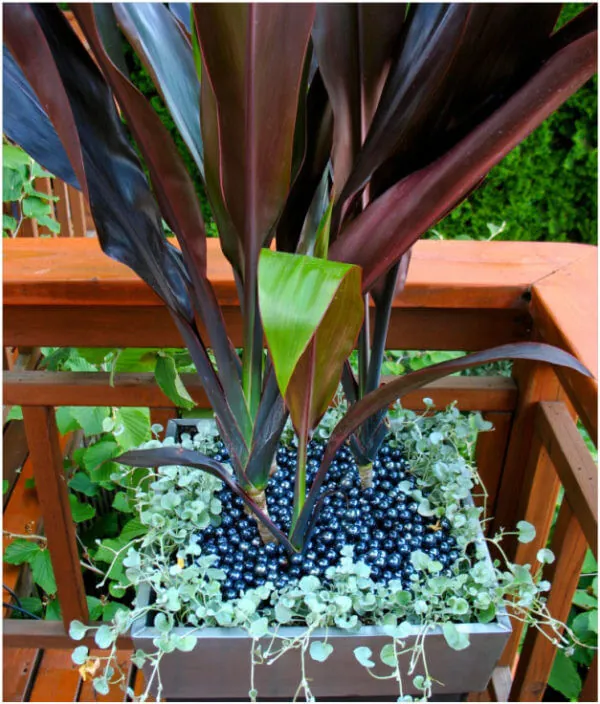
38. Tower Planters
Great space saving solution for you: make vertical gardens! If you cant go horizontal, go vertical! This one will take some wood crafting skill but the end result is definitely worth it.
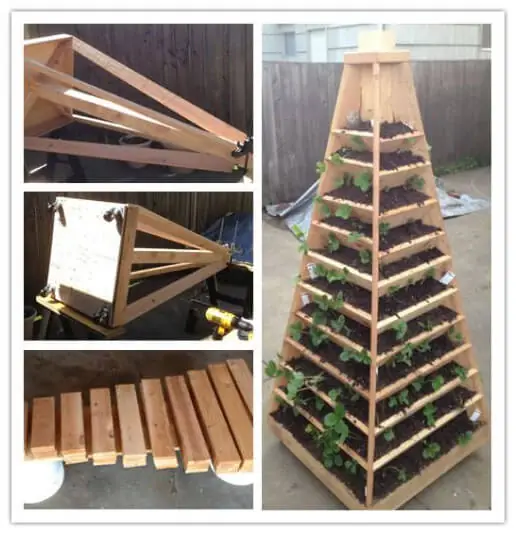
39. Seashell Planters
These hanging seashells were being used to grow small plants. Succulents are great candidates.
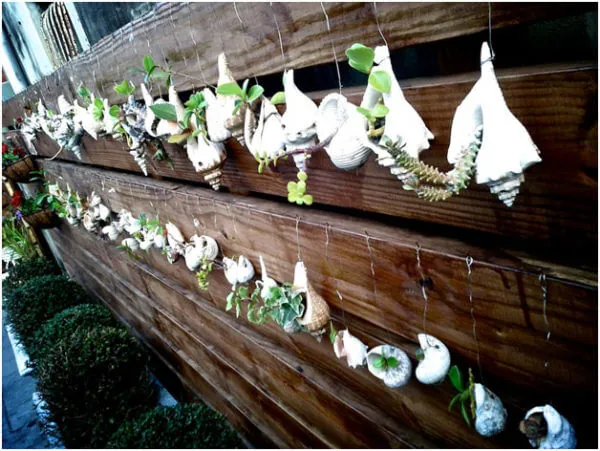
40. Spoons for Hanging Planters
Add personality and charm to your garden. You don’t have to look far. Upcycle some items around like using old spoons to hang planters.
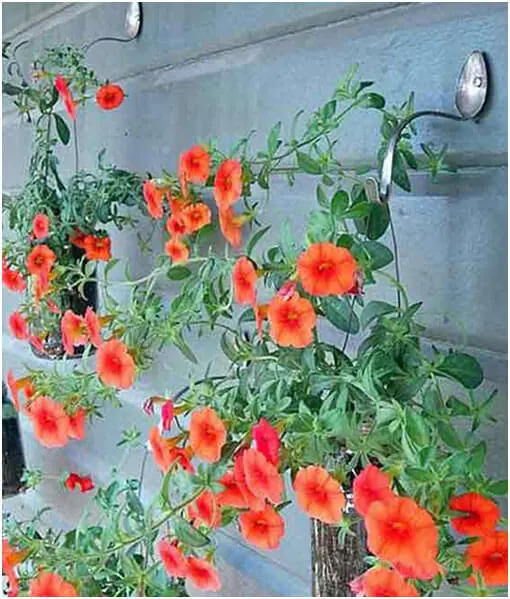
Image Credit: http://www.goodhousekeeping.co.uk/lifestyle/home-decoration/clever-diy-ideas-for-pretty-balcony-patio-furniture-decorating-ideas
41. Natural Shade
To get a unique touch on your garden, plant flowering vines on an umbrella shaped-wire mesh. The result is classy way of getting shade on your garden.
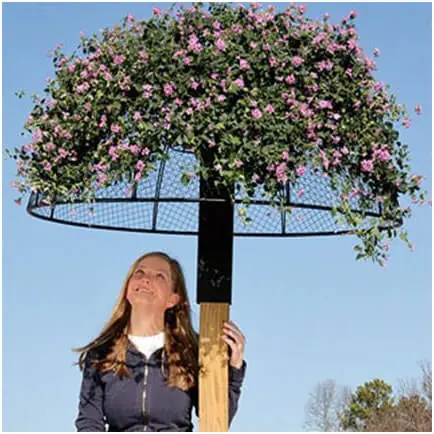
42. Rocks as Garden Markers
You could use paint, nail polish or even chalk to label rocks and place them around your garden to help identify plants.
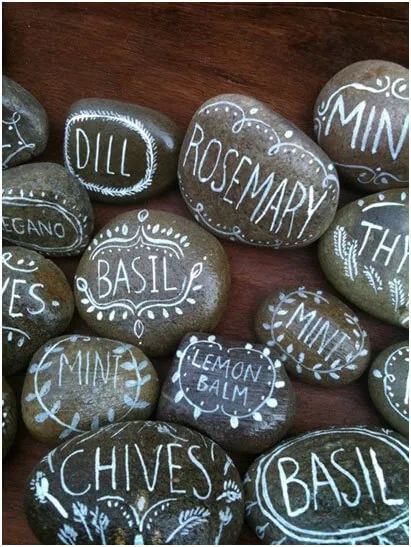
43. Mini Garden in a Container
Add scenery onto your planters using miniature benches, garden tables, fences and etc. You can even put your creativity to work to recreate scenes.
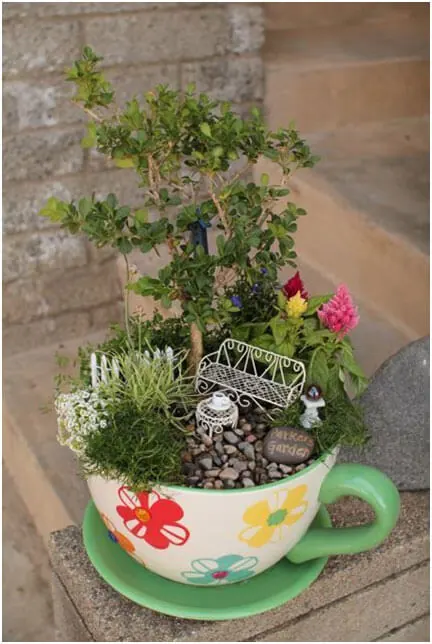
44. Design Your Kitchen with Herbs
It’s not just for aesthetic value. You can actually grow fresh herbs for cooking right there on your own kitchen. Need some mint or a sprig of thyme? They’re within arm’s reach. Did I mention they smell good too?
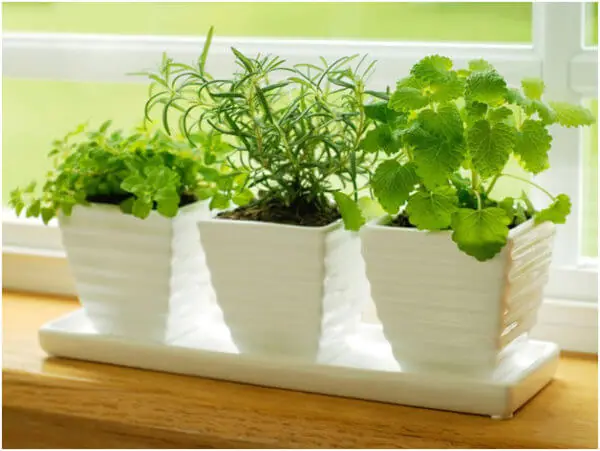
45. Add a Relaxing Scent, Use Lavenders
Most people want a garden as a place for relaxation. Reduce stress levels better by planting aromatic plants such as lavender.
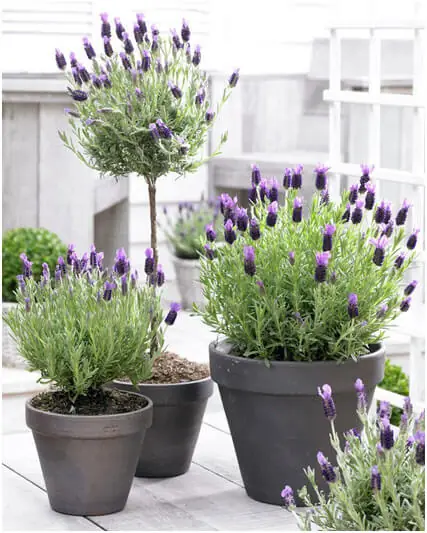
46. Help Planters Drain Properly
When preparing planters, you don’t fill it entirely with potting soil. You first need to add a layer of loose material like broken terra cotta pots, polystyrene chips, pebbles, wood chips/bark, or like in the case below, peanuts. After that, add a layer of fabric before the potting mix. This helps the potting mix drain properly and also prevent dirt from blocking the drain holes.
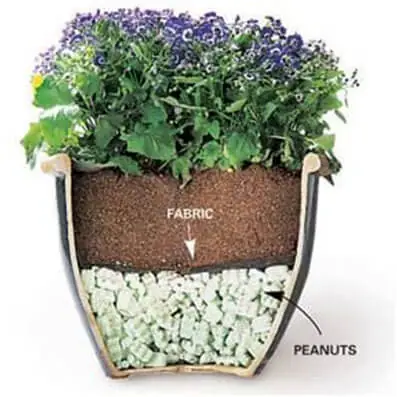
47. Tiered Plant Stand
If you don’t have different sized planters, you can make a tiered plant stand to give height to your planters. This way you can layer the composition of your different plants.
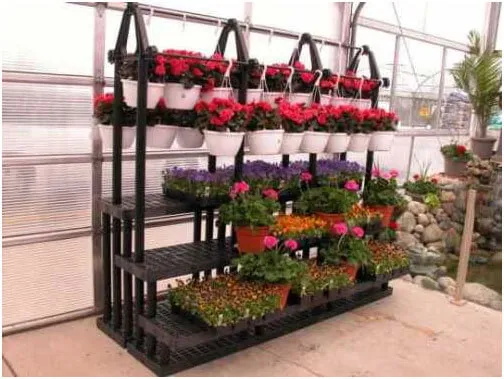
48. Terrarium
Take a glass container with an opening wide enough for your hand. Add a layer of fine gravel and then potting soil. You can now add your plants to make a scenery. Good choices include ferns, succulents, mosses, and miniature moth orchids. You can even add some figurines to create a scene.
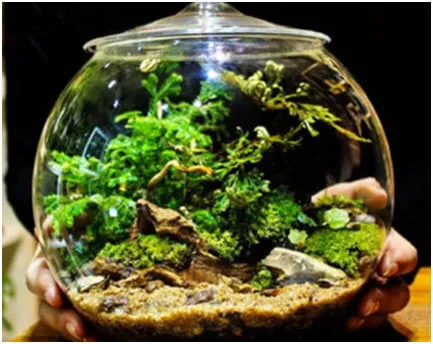
49. Broken Pots Turned Into Beautiful Fairy Gardens
A broken clay flower pot doesn’t have to be thrown away. With a little bit of imagination give it new life as a landscaped miniature garden scene.
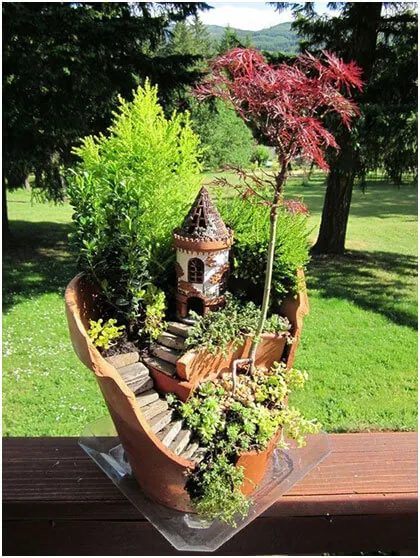
50. Vertical Clay Pot Garden
Stack each pot using ropes. You can use these not just on small areas as a space saver but also around large spaces to separate areas around your garden. You can also do this for small lightweight fiberglass pots. Since they are more durable than terra cotta pots, they will last longer.
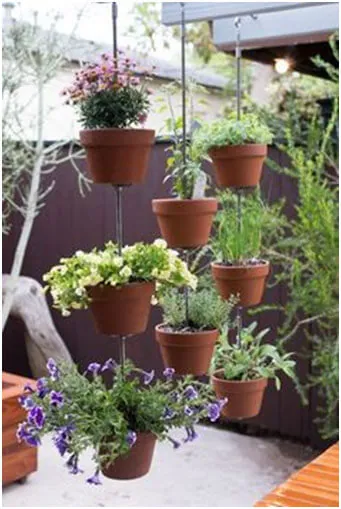
51. Toy Car Planters
Honor your favorite toys as a child by turning them into stunning succulent planters.
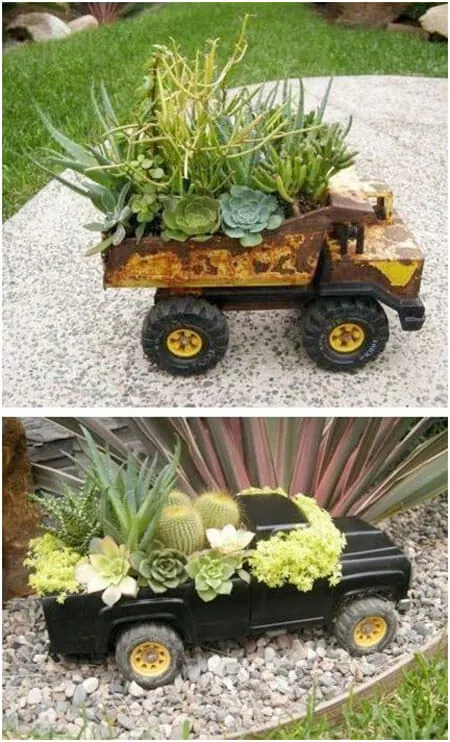
52. Easy Way to Create a Two-Tiered Pot
Use a smaller pot and get it upside down inside the larger pot. This will now serve as the stand for the third pot which will be placed on the top. Viola! An elegant two-tiered pot.
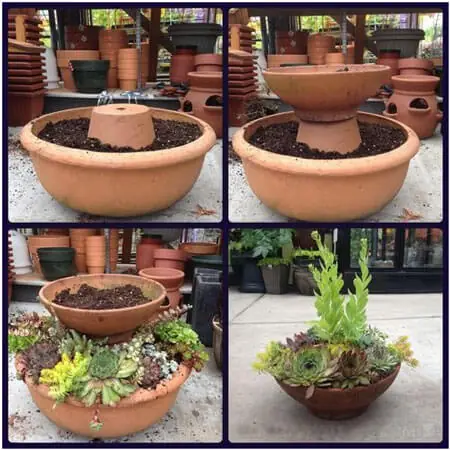
Image Credit: http://www.amandakaram.com/
53. Use Dried Twigs to Spruce up Planters
You can use dried twigs to spruce up your planters. Stick them in the soil or bind them together. You can even paint them. Make it a part of your thriller, filler, spiller design. The only limit is your imagination.
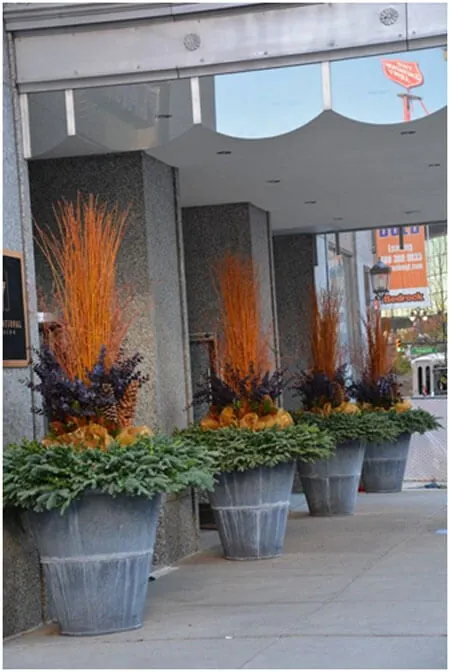
Image Credit: http://www.deborahsilver.com/blog/stick-work/
54. Plant Citrus in Pots
Citrus like lemon and lime have dwarf varieties that you can easily grow in pots. They look good in your garden too especially when they start to bear fruit. Lemonade anyone?
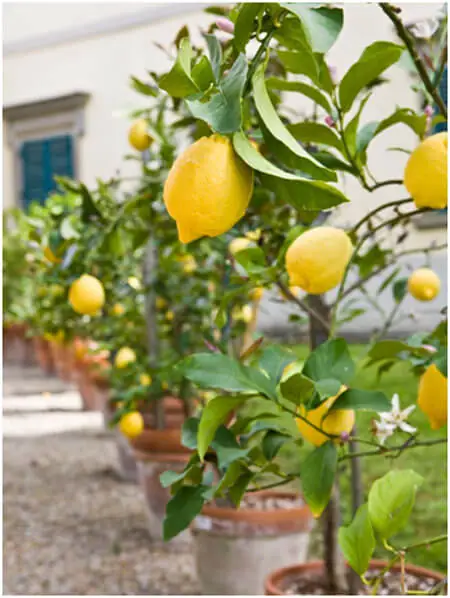
55. Clinging Vines and Wood Structures: A No Go
Do not place vines near wood structures like posts and fences. As plants tend to keep moisture, they will cause rotting in the wood.
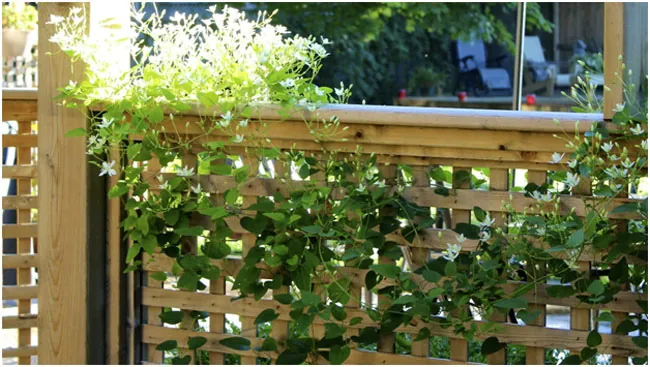
56. Grow Vegetables between Your Ornamental Combinations
You can plant your vegetables in the same pot as your ornamentals. Good candidates are peppers and tomatoes. The fruit will even add to aesthetic appeal not to mention you get fresh produce.
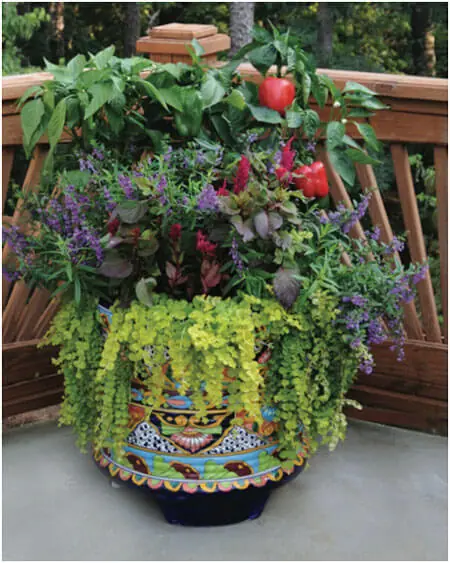
Image Credit: https://bonnieplants.com/library/easy-container-combos-vegetables-and-flowers/
57. If You Do Container Gardening, Work On Site
Remember that a fully filled planter may be quite heavy. So set it where it’s supposed to be before you start filling it up. To move to the actual site you want it to be.
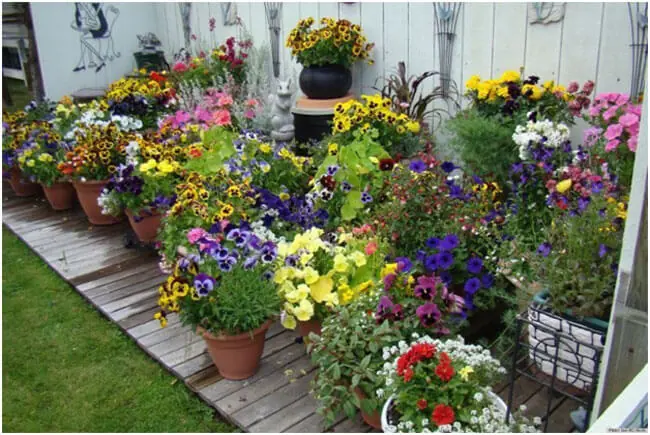
Image Credit: http://www.huffingtonpost.com/2013/04/13/pretty-container-gardens_n_3069509.html
58. Combine Similar Colours with Different Shapes
A guaranteed combination is to use a simple colour theme and use different shapes and shades around your arrangement.
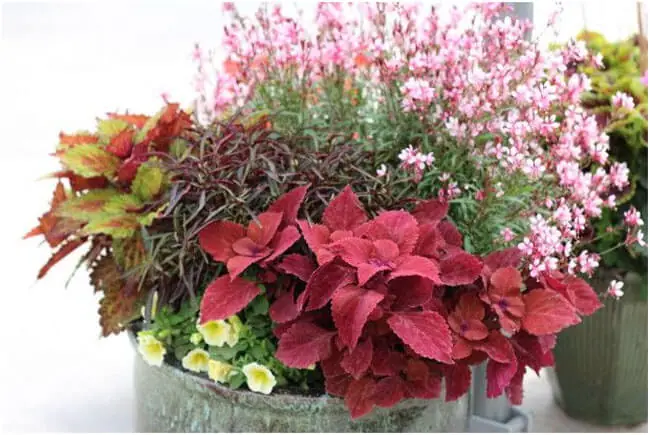
Image Credit: http://www.hgtvgardens.com/container-gardening/16-creative-container-designs
59. Contrasting Shapes and Complimentary Colours
The key to this arrangement is the contrasting purple-yellow combination and the reds-green compliments. The contrast in colours brings in focus to the main flowers and ties the overall harmony of the combination.
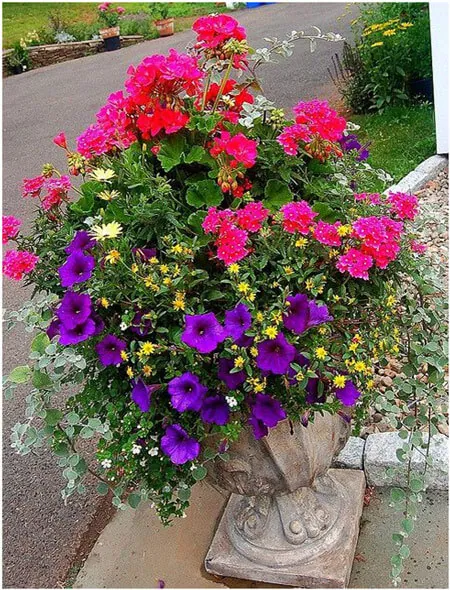
Image Credit: https://www.flickr.com/photos/27839922@N02/2774932141/
60. Ensure Proper Drainage
Cover the drainage holes with a mesh screen to prevent them from clogging and to keep soil from washing through onto your patio or deck.
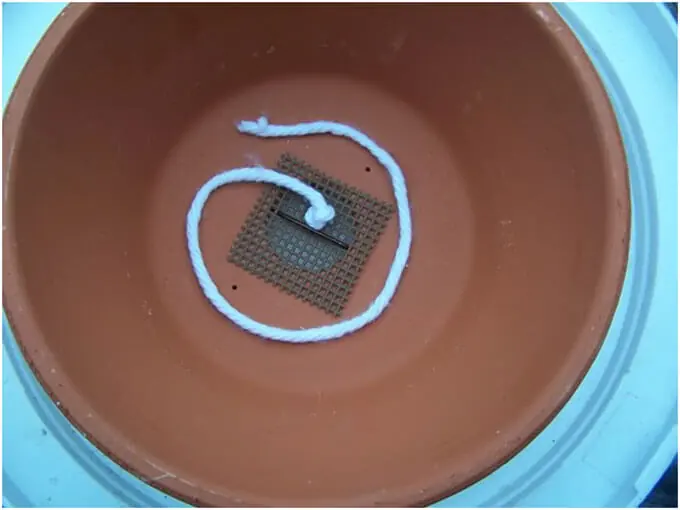
61. Plant from the Inside Towards the Edge
When starting an arrangement, start from the inside with a tall plant as a thriller. Then work on the sides towards the edge with a lush plant as filler. Lastly, bring in the spillers near the edge and make them flow.
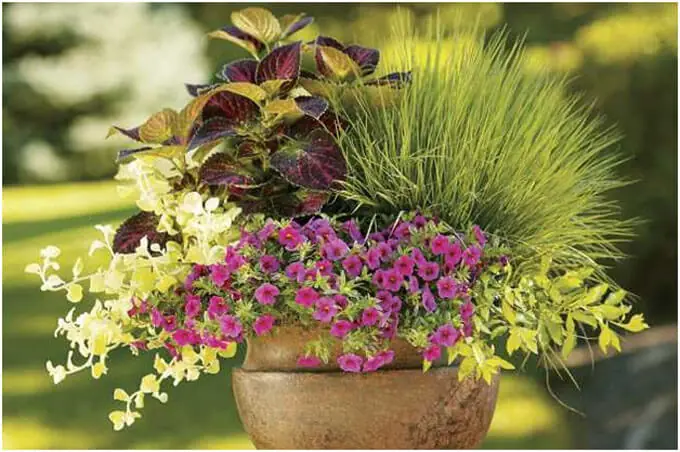
62. Keep the Colour Scheme Simple
Avoid a cluttered look on your container arrangements. As a rule of thumb, either use different shades of the same colour or use a complimentary colour scheme in your combinations.
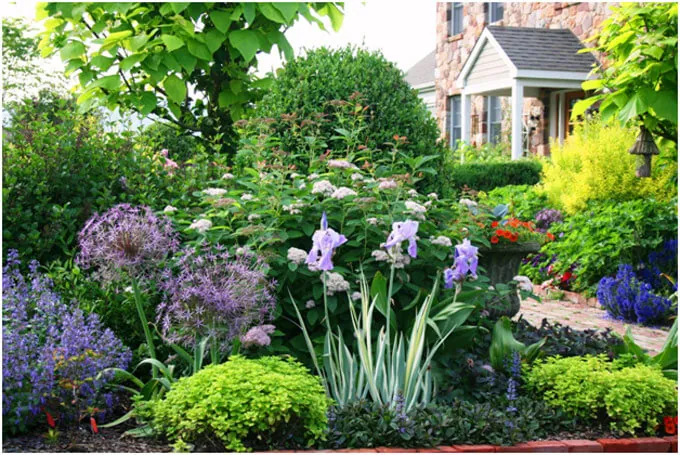
Image Credit: https://lindenhillgardens.com
63. Make a List Before You Go to Buy Plants
Before you go visit a nursery, make a list of plants that you need. Making a list ensures that you only buy what you need. You can also try listing down alternatives in case the plant you’re looking for is not in stock.
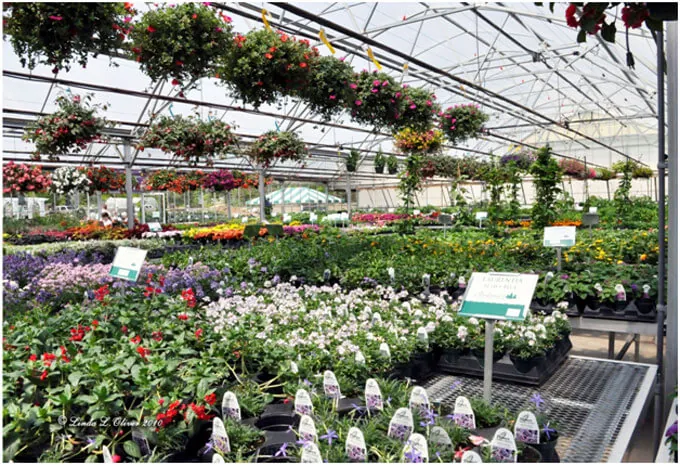
64. Sometimes Plants Die; Deal with It
Plants die all the time. Even the most experienced gardener will kill a few plants. Sometimes it might be best to just give up on a plant rather keeping it there wilted and dry hoping it would spring back to life.
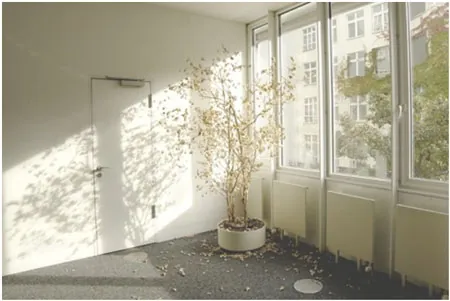
65. Learn How to Tell if Your Plants Need Water
Many gardeners kill their plants by overwatering more than underwatering. Stick your finger in the soil, if it’s moist underneath, no need to water yet. If it’s dry, you know what to do.
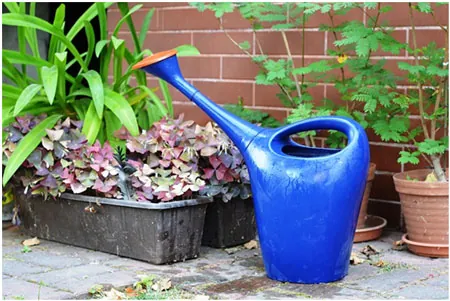
66. Avoid Awkward Plant to Pot Ratio
The overall height of your arrangement should be as tall as your container. This is a basic rule of thumb but don’t be bound by it. There is always an exception to the rule.
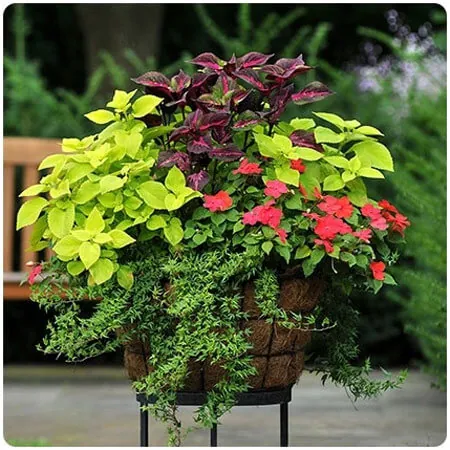
Image Credit: http://blackthumbgardener.com/
67. Accent Stairwells with Colourful Potted Plants
Accentuate outdoor stairwells with colourful potted plants. The plants actually soften the design full of corners and hard geometry and make it more pleasing to the eye.
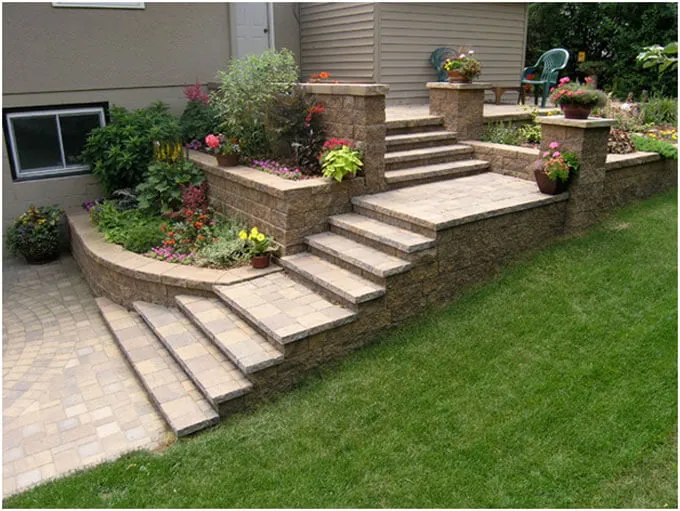
Image Credit: http://www.houzz.com/photos/6142880/Stairs-traditional-landscape-minneapolis
68. Grasses as Container Plants
Grasses, hedges and rushes most of the time are used around the garden to fill up the ground with foliage. But because of their texture and height, garden designers are starting to use them in container combinations as one of the main players.
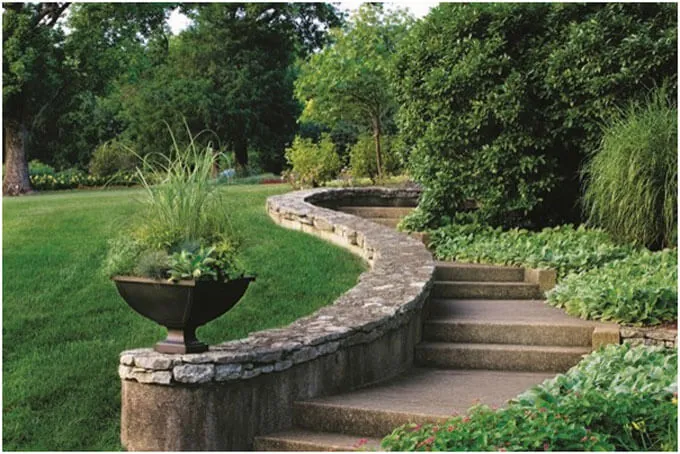
Image Credit: http://www.gardendesign.com
69. Use Container Planters on Your Guard Railings
This will not only aesthetically serve the area but also it will keep you at a safe distance from the rails.
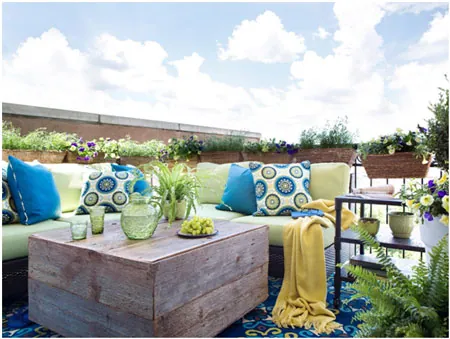
Image Credit: http://hgtvhome.com
70. Know Your Plants
You know those tags that came with the plants when you got them from the nursery? Keep them as they contain important information about your plants. If you lost them, use Google to keep yourself knowledgeable about your plants.
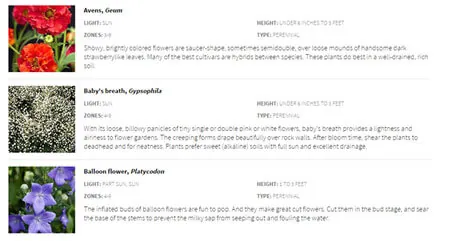
71. Know Your Plant’s Growth Habits
There are plants that grow tall towards the sun. There are some that spread to get more sunlight. Some are crawlers. Some are shade lovers and stay low. Learn the growth habit of your plants lest the end result could be a chaotic one.
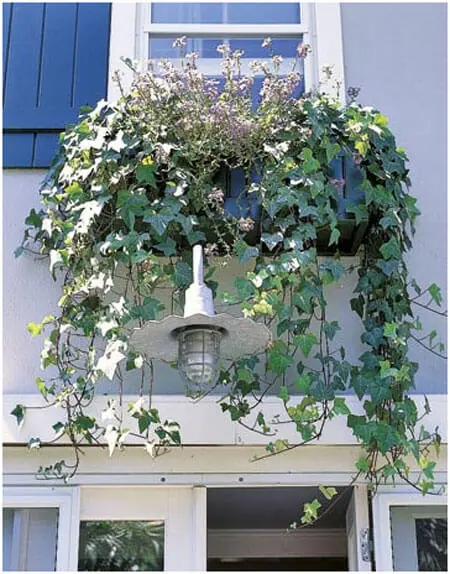
Image Credit: http://www.countryliving.com/gardening/garden-ideas/advice/g735/container-gardens-0309/
72. Contrast Containers with the Plant Qualities
You can change the personality of the plant by its container. Match a simple container to an eye-catching plant or put a simple plant in a dramatic container.
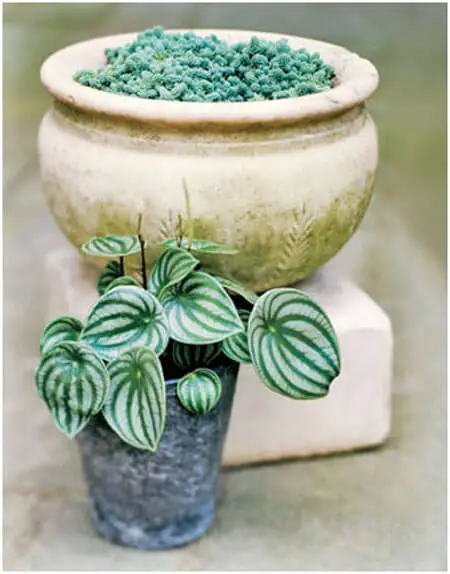
Image Credit: http://www.countryliving.com/gardening/garden-ideas/advice/g211/architectural-plants-0705/
73. Soil-Free Potting Mix
Do not use soil for container gardens. Use potting mix. They have more nutrients, they retain moisture and aerate better. Use a layer of rocks at the bottom of the plant to aid in drainage and prevent blockage of drain holes.
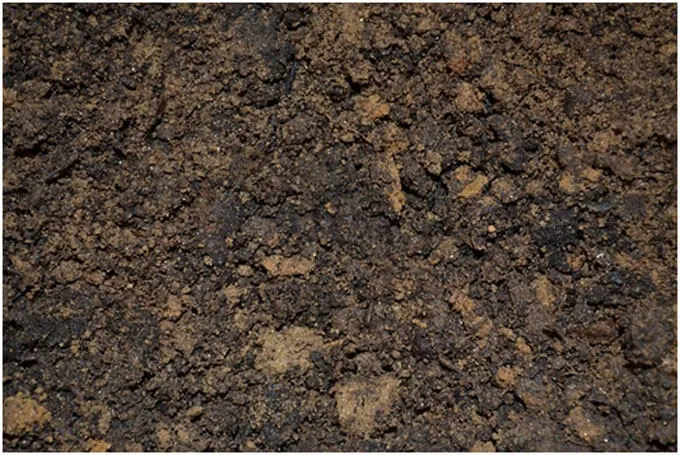
74. Clay Pots vs Plastic Pots
Plastic pots keep the moisture in the soil better but clay pots are aesthetically better. Clay pots are like fine wine that gets better with age. If you want to have the benefits of both, try planting in a smaller plastic pot then placing it on a larger clay pot. Cover everything with soil up to the rim.
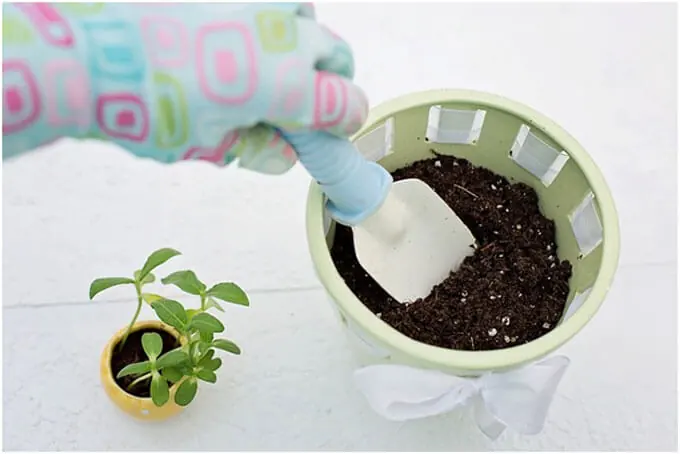
75. Start with the Greens
It’s better to start with green leafy plants if you’re a newbie gardener. They thrive better than flowering or fruit-bearing plants. There’s more room for error when you are just starting out gardening.
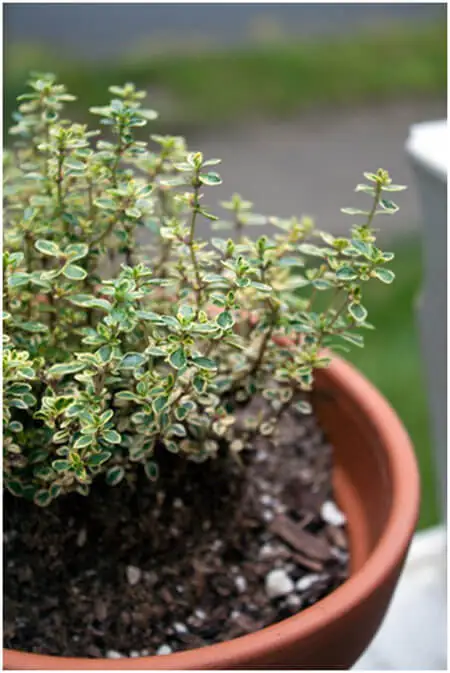
Image Credit: http://www.apartmenttherapy.com/top-10-best-easiest-herbs-to-grow-in-your-garden-and-how-to-use-them-147026
76. Get a Book on Gardening
Knowledge is power and that holds true for gardening. Get lessons from the experts and read a book on anything gardening.
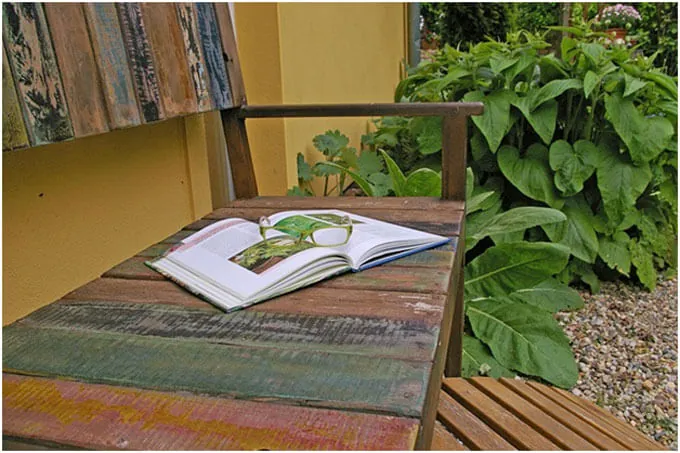
77. Orchids on Planters
Orchids are one of the most beautiful flowers in the plant kingdom. Their exotic look combined with their elegant structure is a knockout combination. They may be a challenge to take care of but getting a bloom out of them is truly rewarding. And yes, you can grow them on planters too.
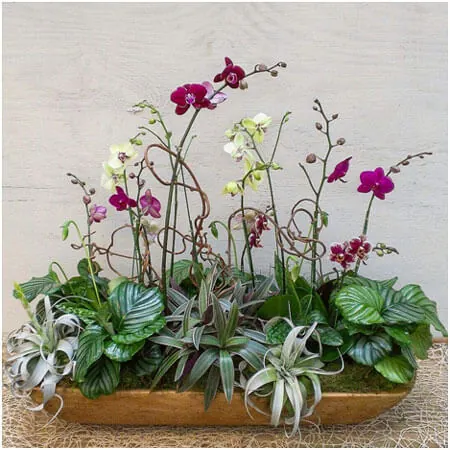
Image Credit: http://oakstreetgardenshop.com/arrangements/
78. Garden for All the Senses
Wind chimes are as important as nice fragrances. If you have some small trees, hang a few wind chimes. Believe me, those afternoon breaks in your garden will be that much better.
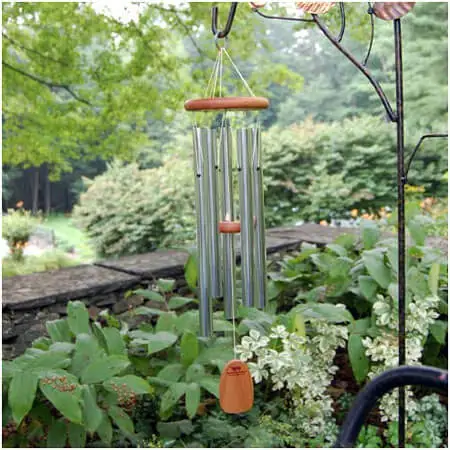
Image Credit: http://www.japanesestyle.com/wind-chime-chimes-kyoto
79. Have Something in Bloom Every Season
Use plants that bloom on different seasons so your garden will look good any time of the year. There will never be a dull moment in your garden.
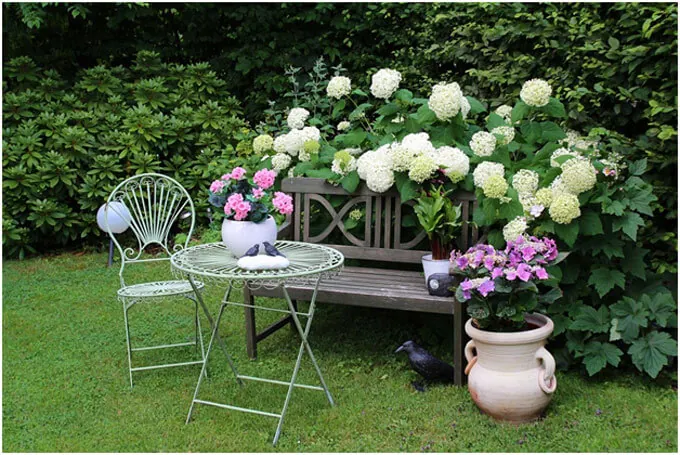
80. Design Your Landscape for People-Comfort
Include all-weather seating, dry paving, shade in summer, and wind protection in winter.
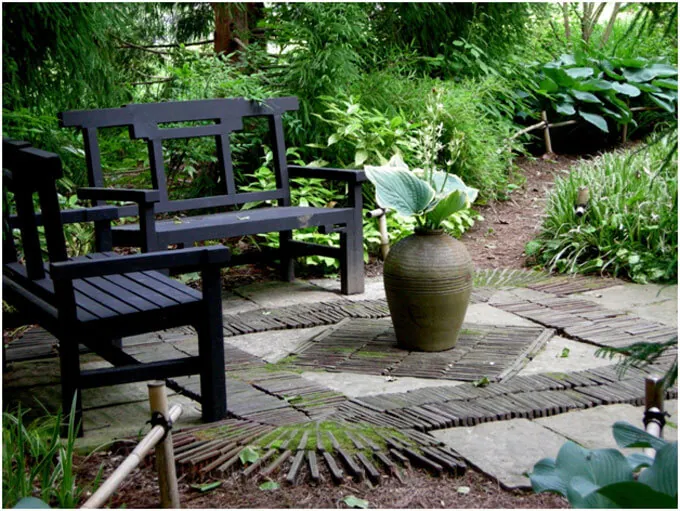
Image Credit: http://www.avso.org/interior-design-ideas/20-stylish-ideas-for-outdoor-seating-area-a-comfortable-seating-area-in-the-garden
81. Change Your Plants Easily by Setting up a Buried Pot Garden
This makes landscaping easier especially during change of seasons, as you won’t need to dig up an old plant to replace it. This also keeps everything in its right place.
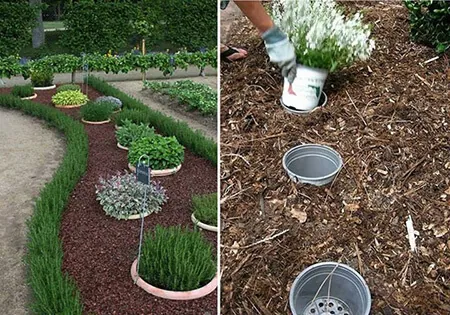
Image Credit: https://www.buzzfeed.com/peggy/easy-backyard-diys?utm_term=.vubKa38WJ#.dnqpklYBK
82. Create a Yard Environment that Welcomes Wildlife
Put out a bird bath. Install a birdhouse or have a pan high up with some birdseed. Take out your camera and take pictures of the different varieties of birds that visit your yard.
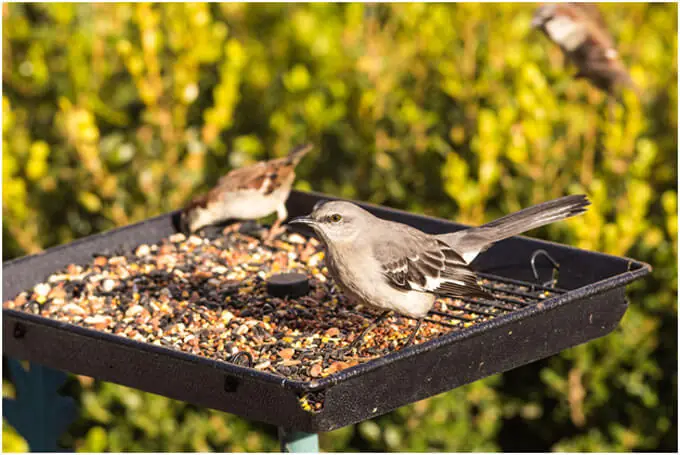
Image Credit: http://smallgardenideas.net/problems-with-bird-seed-in-the-garden/
83. Keep a Garden Journal
Include photographs. Take note of the dynamics of your garden. Gardening is a continuous journey so keep track of where you have been with your yard and where you are now.
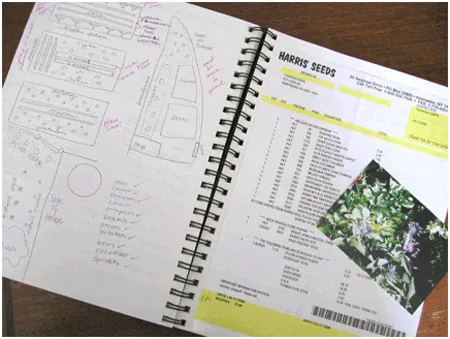
84. Keep Yourself Updated on Design Trends
From new tips to seasonal changes to new design trends, you might want subscribe to newsletters from garden design blogs to keep yourself updated.

85. Enrich the Soil
Remember you feed the plants by feeding the soil. You can use commercial fertilizer or make your own compost.
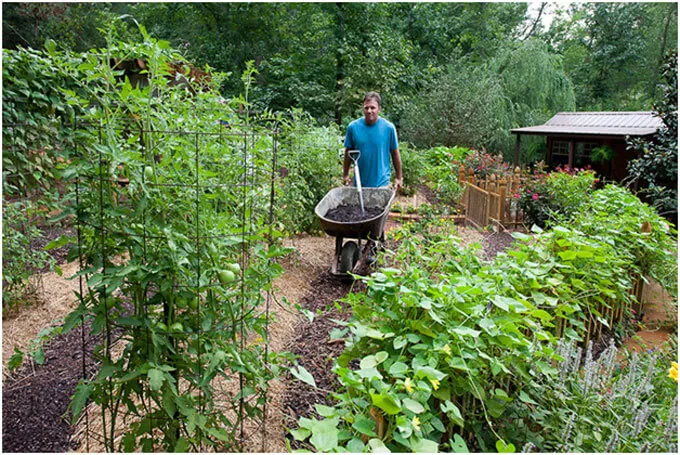
Image Credit: https://bonnieplants.com/library/feeding-the-soil-feeds-your-plants/
86. Consider Fruit Bearing Plants
Berries are good candidates for container gardens be it for ornamental purposes or for the berries themselves. Blueberry pancakes anyone?
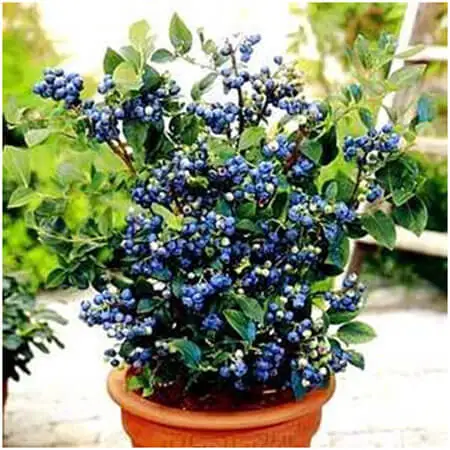
Image Credit: http://gardenofeaden.blogspot.com/2012/04/how-to-grow-blueberries.html
87. Recycle an Old Bird Cage
Got an old bird cage but no birds? Turn it into a planter. Plant some succulents and make them overflow. A layer of mesh on the sides will prevent the potting mix from being washed away when watering.
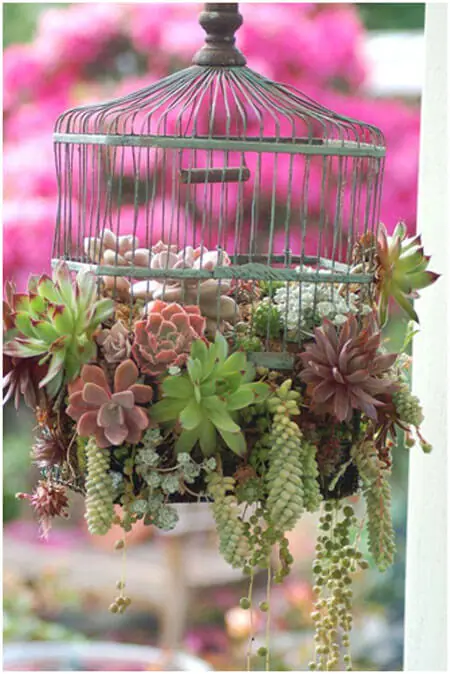
Image Credit: http://www.craftberrybush.com/2014/05/how-to-plant-succulents-in-a-birdcage.html
88. Play with Textures Not Just with Colours.
Greens are always easy to the eyes. To make it work, play with different textures of greens to give depth and guide the eyes towards the centrepiece.
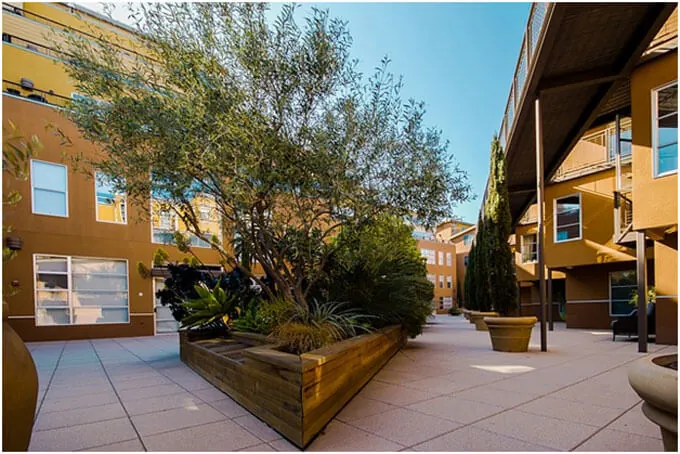
89. Add a Butterfly Feeder
Attract more butterflies to your garden with do-it-yourself butterfly feeders. Mix one part sugar in 10 parts water for the food. Pour this mixture over a sponge and saturate it.
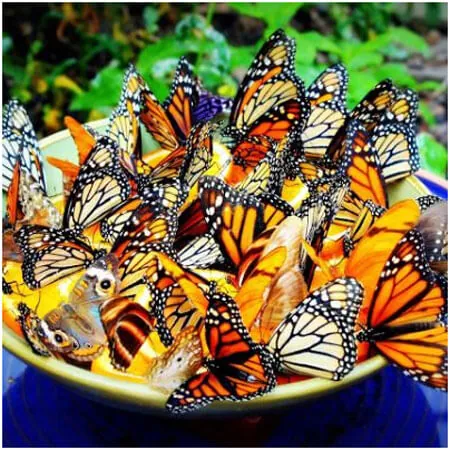
Image Credit: http://www.growrealfood.com/dyi/make-a-homemade-butterfly-feeder-to-attract-butterflies-to-your-garden/
90. Old Tub Planter
Remodelling your bathroom and don’t know what to do with the old tub? Drag it to your yard. Drill some drain holes. Add a layer of sand and then some potting mix. Then plant away.
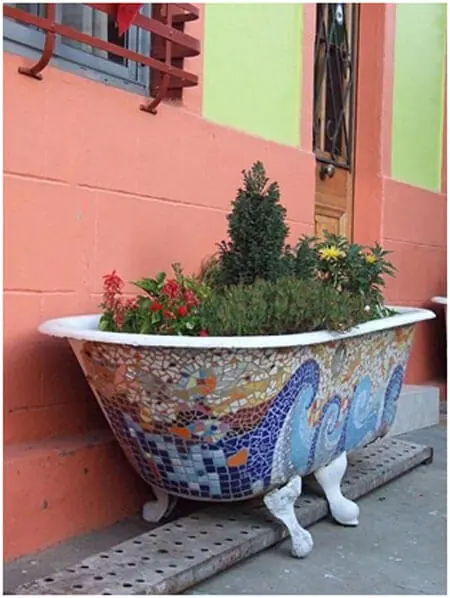
Image Credit: http://kisas.tumblr.com/post/30791205034
91. If Space is a Problem, Plant in Tall Pots
If there’s not a lot of space to accommodate plants, use tall planters. They won’t take as much space and you get to have plants.
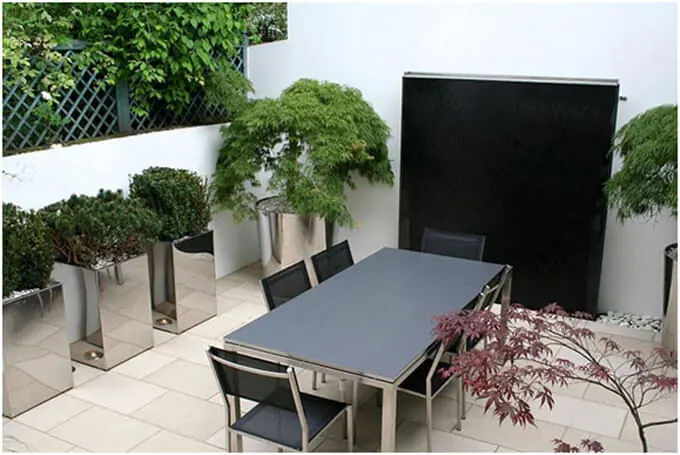
92. Colander Planters
Because they’ve already got the holes for drainage, they’re perfect for potting plants. You can even paint the colander before you start planting.
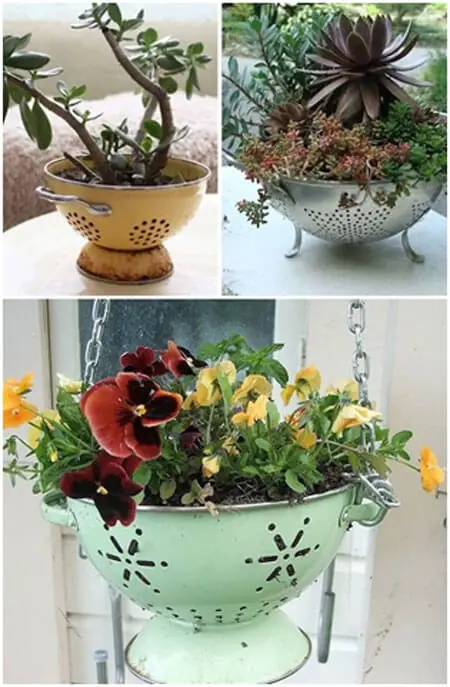
Image Credit: http://blog.gardenloversclub.com/container-gardening/recycled-hanging-baskets/2/
93. Cinder Blocks Planters
Stacked cinder blocks have readymade compartments that are ideal for a variety of plants. You can stack and build them to create a wall or fit a custom space. It’s like playing Lego with plants.
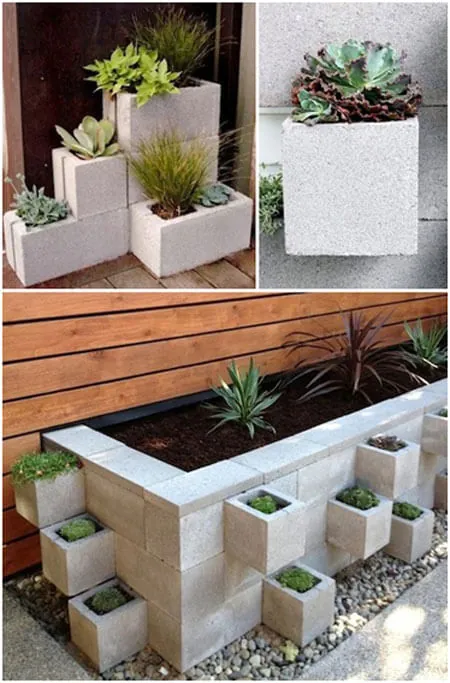
Image Credit: http://www.icreativeideas.com/20-creative-uses-of-concrete-blocks-in-your-home-and-garden/
94. Tool Box Planters
If you’re aching to get a shiny new tool box, just go ahead and do it. The old one can be an ideal planter. Just don’t skip on the drain holes.
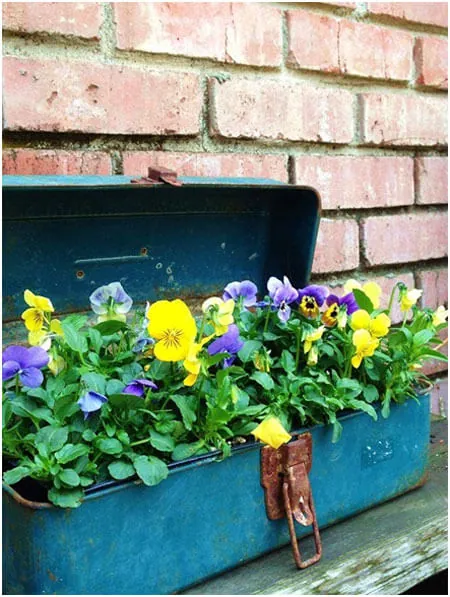
Image Credit: https://www.pinterest.com/pin/39688040441863518/
95. Flowers are Just One Part of the Design
While flowers in bloom are very attractive, most only last for a few days. There are plants that offer more than just their blooms. Consider foliage, fruits, and barks for a lasting colour and texture all year round.
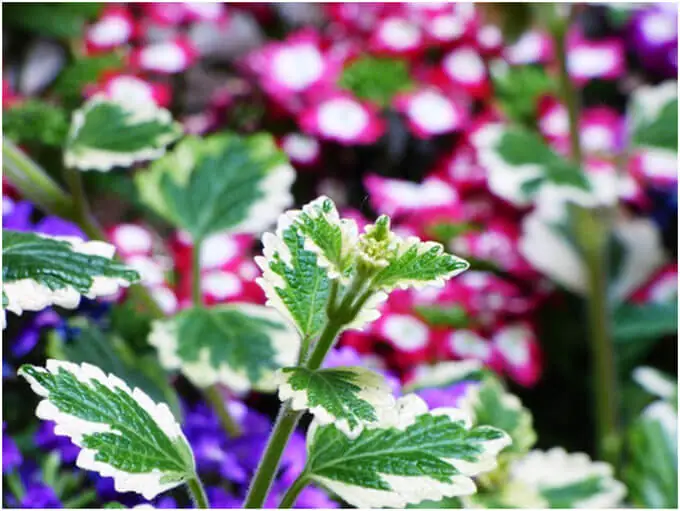
96. Tire Planters
We love the new tire trends. They’re being upcycled in so many unique ways! With a little bit of creativity, you can add them to your yard, too.
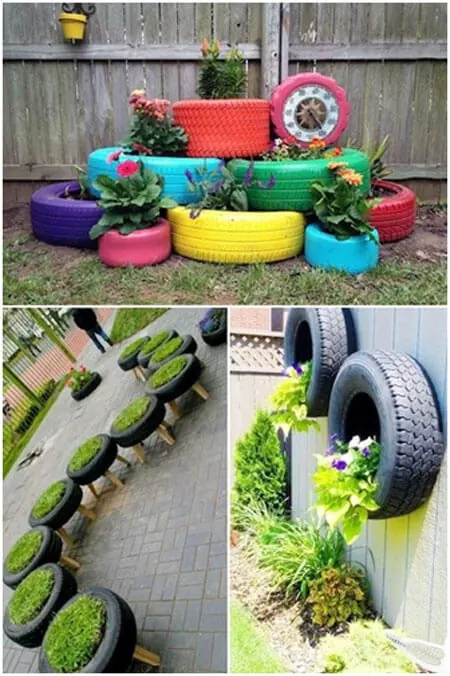
Image Credit: http://www.decorcus.com/home-design/twelve-innovative-and-distinctive-backyard-tips.html
97. Light Bulb Planters
This is a great way to upcycle old light bulbs. They look good but are very fragile so handle with care.
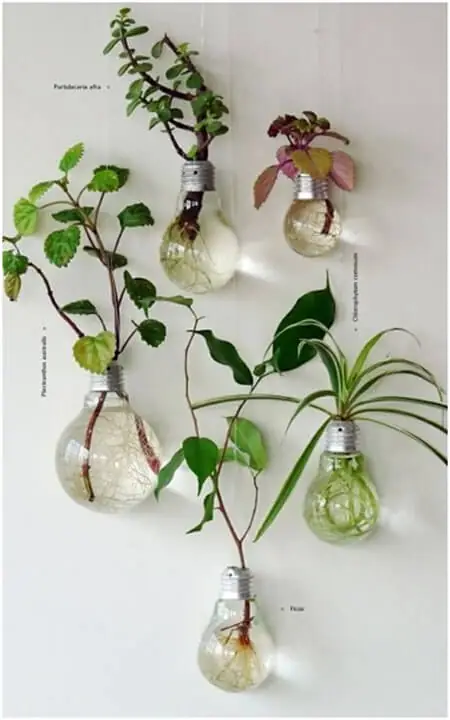
Image Credit: http://recyclenation.com/2011/08/planters-recycle-light-bulbs
98. Teacup Planters
Need a good pot for planting herbs in your kitchen? You may not need to look too far. Get some old teacups from your cupboard and carefully drill some drain holes. Not only will it look good, it will also be a good fit for your kitchen design.
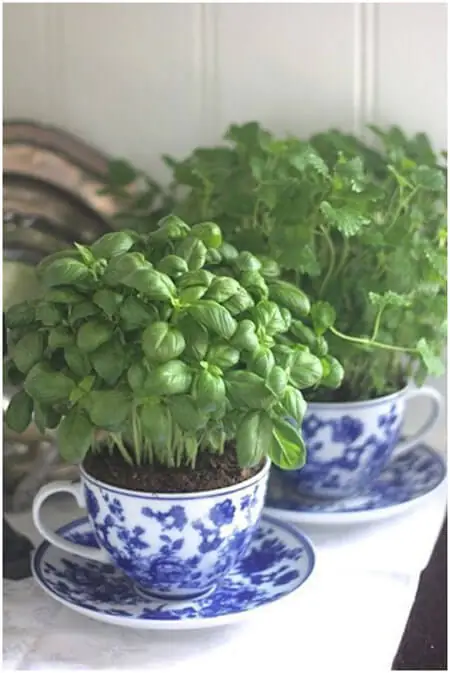
Image Credit: http://www.refinery29.com/top-pinterest-images?crlt.pid=camp.NYEnIwA4HFDc#slide-5
99. Chandelier Planter Holder
Now you won’t need to throw out that old chandelier. This will require a bit of work so just follow the instructions here.
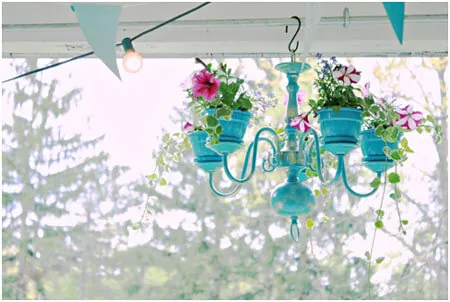
Image Credit: http://diyshowoff.com/2013/06/11/chandelier-planter-tutorial-2/2/
100. Sitting Pretty
The lush yellows highlight the red calibrochoa. Aside from being a rail guard for the porch, the striking colour scheme in this wonderful arrangement will draw everyone’s attention.
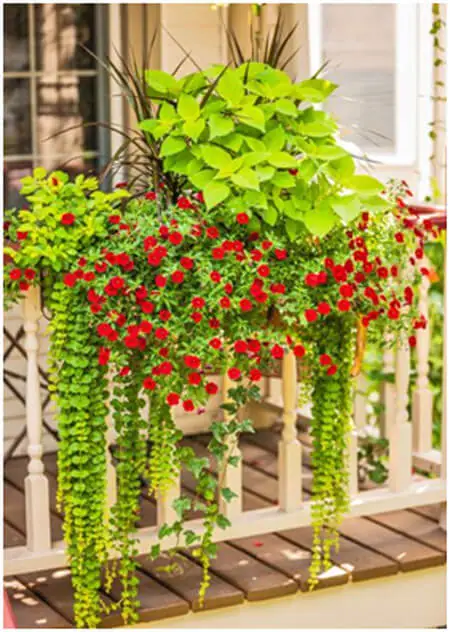
Image Credit: http://www.midwestliving.com/garden/featured-gardens/container-gardens-with-pizzazz/?page=2
101. Bigger Pots are Better.
Large containers hold more soil so they retain moisture better. More room also means bigger root systems. Bigger root systems mean healthier and happier plants. Also, small pots are especially not recommended for large spaces so don’t be afraid to go big.
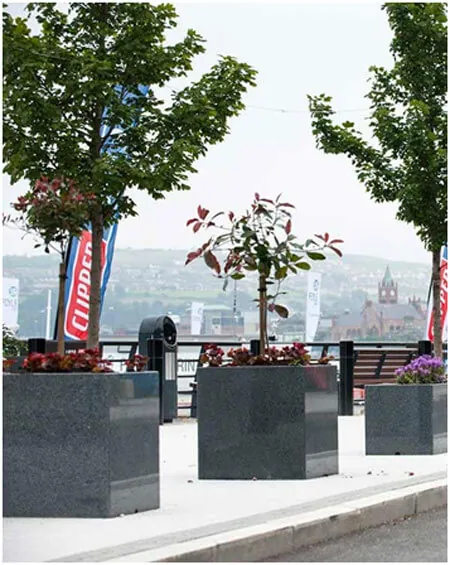
102. Choose the Right Container for the Job
Terra cotta looks great but they break easily. Granite pots are durable but very heavy. Fiberglass pots are lightweight and look great in modern designs. To know more about different planter types, check out this blog post.

103. Greening Your Patio through Container Gardening
To many people, their patio is a place for some R&R. For some, it is a place for receiving guests and holding parties. When greening your patio, container gardening is the perfect solution.
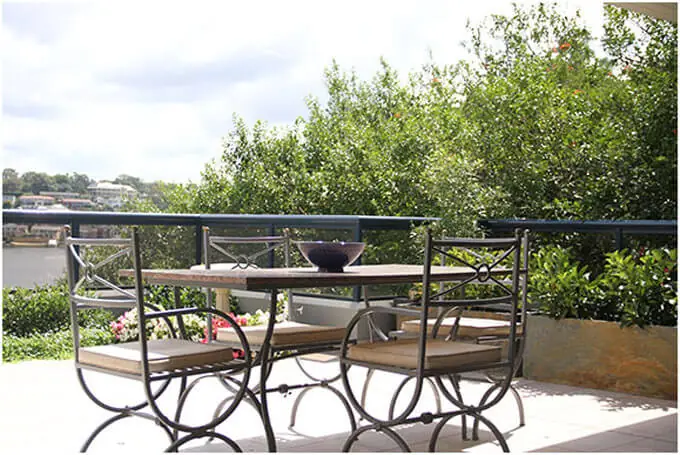
104. Give Hand Pollination a Try
For gardens at higher elevations like in a high rise building, pollination might be a problem due to lack of insect traffic. To free up enough pollen to be effective, you can use a brush, cotton buds or just give your plants a good shake.
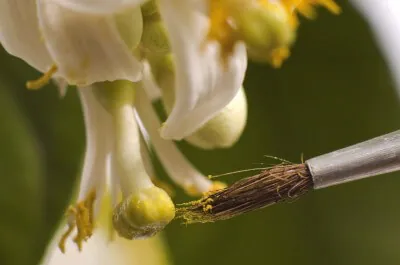
Image Credit: http://www.gardeningknowhow.com/edible/fruits/lime/hand-pollinating-limes.htm
105. Bring Ceramic and Terra Cotta Pots Indoors During Winter
Ceramic and terra cotta pots that have soil in them can crack or break when left outside during winter. Keep them indoors in your tool shed or garage so you can use them again.
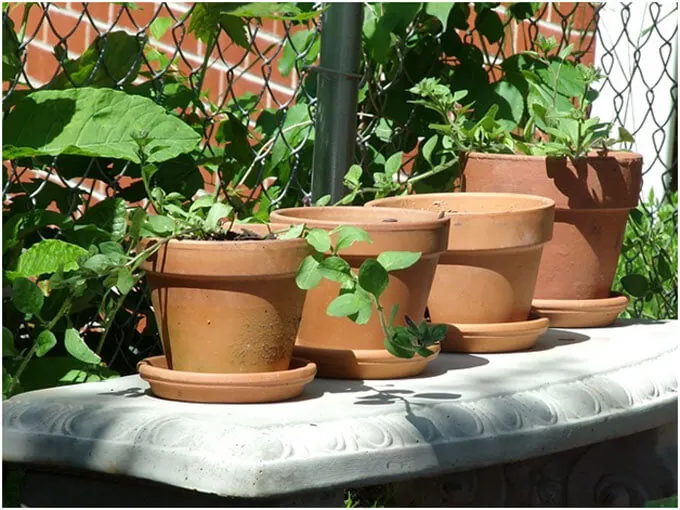
106. Love Salsa? Grow It in Containers
If you love salsa, then you must know that you can easily grow salsa in containers. Well, not salsa in the literal sense but the ingredients you need for salsa. Check out this link for more information. And bring out the chips please.
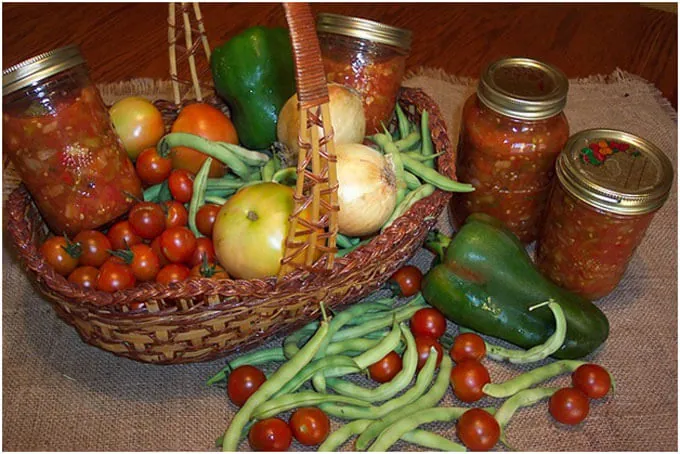
107. Clear Container Water Garden
Container gardening is also for aquatic plants such as the lotus plant. A transparent container will look good. The fish in the container is not just for aesthetic purposes though. It can prevent mosquitoes from laying eggs on the stagnant water.
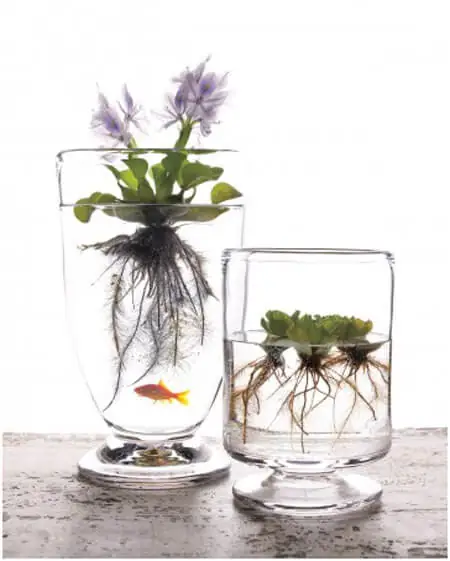
108. Keep the Mints Within Reach
Mint can be invasive so keeping them in pots is ideal. Fresh mint leaves make a refreshing garnish for drinks on a hot summer day so keeping potted mint plants within arm’s reach is a real treat.
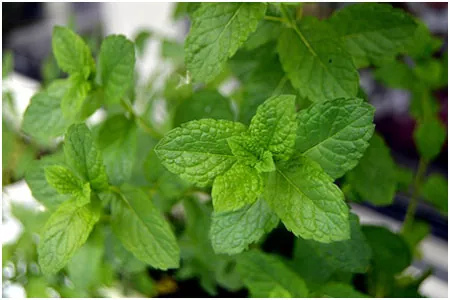
109. The Hanging Ball of Lush Succulents
Succulents are beautiful in their own right. However they grow so low that they are most of the time underappreciated. Bringing them within eye level like this arrangement captures the viewer’s interest easily.
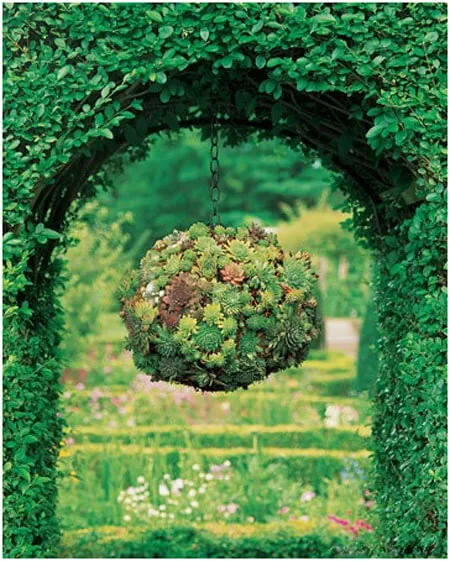
110. Feed Your Roses with Slow Release Fertilizer
If you are fond of roses, you should know that in order to continue blooming they need a constant supply of nutrients in the soil. Put in some slow release fertilizer to keep them in bloom.
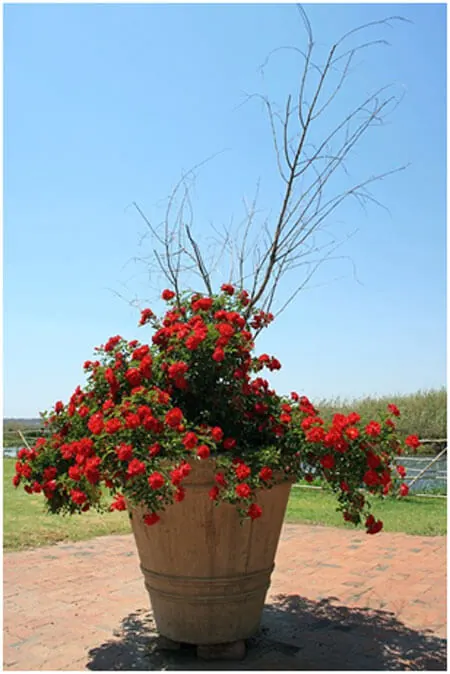
111. Use Eggshells as Fertilizer
Eggshells are high in calcium which is good for plants too. When you crush eggshells, its jagged edges become good deterrents to pests like slugs and caterpillars.
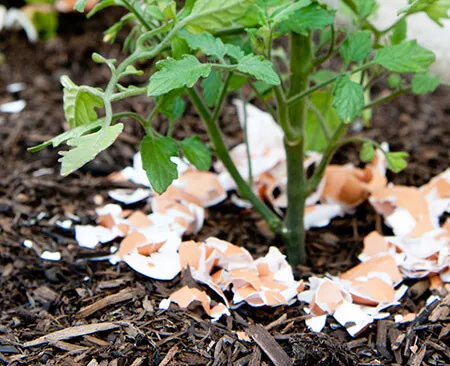
Image Credit: http://thechicsite.com/2014/06/03/eggshells-garden/
112. Plants Don’t Always Have to Start With Seeds
Many plants grow from cuttings like roses for example. If you see a plant that you like whether it’s from the neighbour’s garden or a park, you can simply ask for a cutting. Just don’t go cutting without asking for permission first. Stick it in a pot and it will grow roots. It’s like magic.
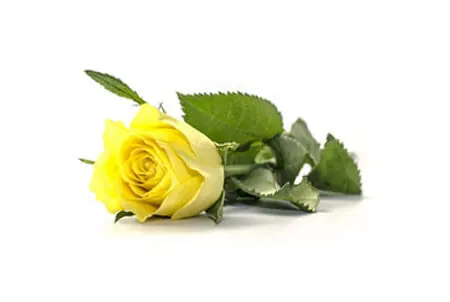
113. Choose Drought-Resistant Plants for Drought-Prone Areas
If you live in an area that gets the occasional dry spell, choose plants that are resistant to droughts. Your local nursery should be able to provide you with all the information you need.
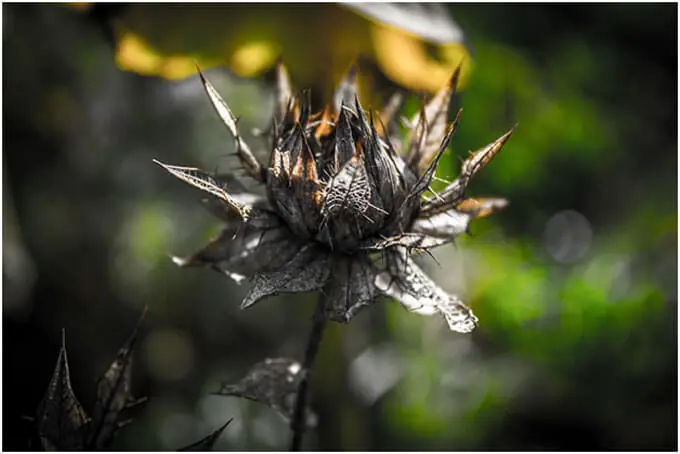
114. Winter Season Gardening
Roots of potted plants are sensitive to freezing temperatures. This is because the roots are above the ground. You can place them inside a shed to mitigate the freezing temperatures or you can invest in frost-resistant pots.

115. Use Drip Irrigation for Stress-Free Watering
The amount of water your plants needs depends on many variables. We suggest a drip irrigation system to automate your watering without wasting water. You can read more about drip irrigation in this post.
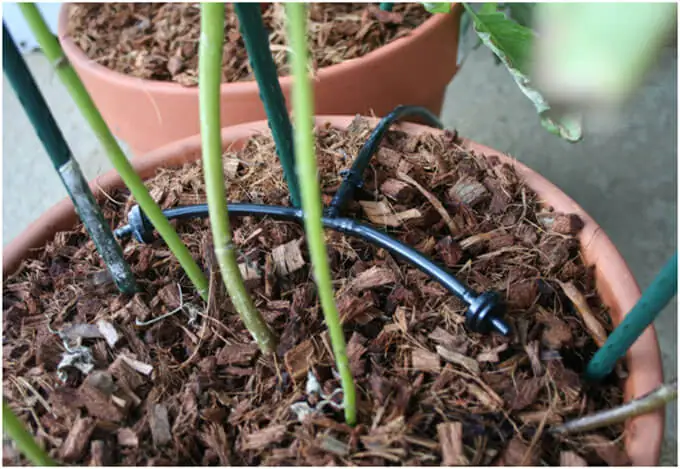
116. Reuse Bottles as Watering Globes
Before you go on a somewhat long vacation, inserting a watering globe will ensure your plants are well watered for a longer period. Note that this is only convenient for container plants that like to be watered regularly. You can use any bottle for this one.
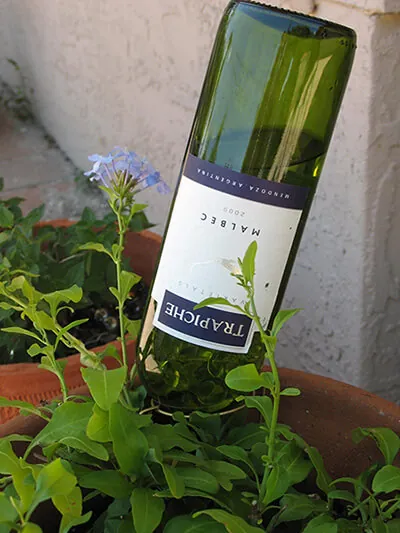
Image Credit: http://wallacegardens.tumblr.com/search/wine+bottle
117. Deadheading
Cut off the wilted blooms to encourage new flowers. This process is known as deadheading.
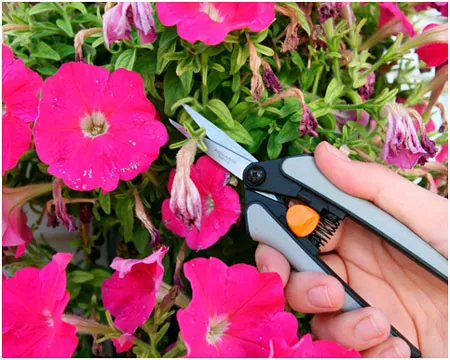
118. How to Deal with Garden Pests
Ideally, you should have taken measures to ward off pests. When they do get in your garden, you should actively bury infected leaves, remove the pest habitat, and plant pest resistant plants.
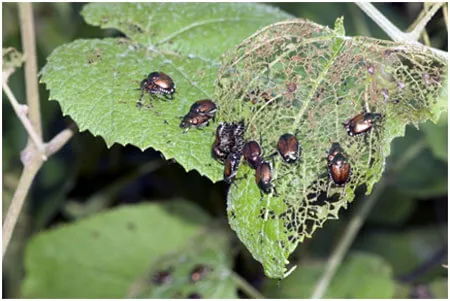
119. When Using Pesticides Always Read the Label
Reading the labels on pesticides and following them ensures that you don’t accidentally kill off your plants and other beneficial bugs.
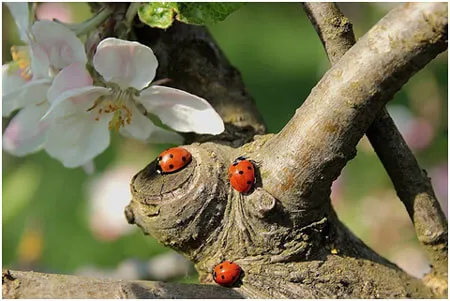
120. Use Trough Planters as Barriers for Pedestrians
Trough planters are effective barriers for separating spaces. In the image below, IOTA’s granite trough planters are being used to separate the parking area from the walkway.
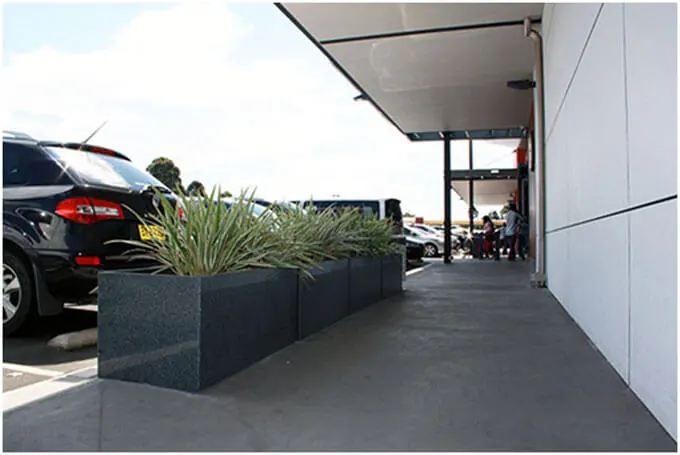
121. Pinch Top of New Stems for a Bushier Plant
If you don’t want a leggy plant, pinch out the growing tip of each stem back to a node using your thumb and forefinger. This encourages side shoots to grow on other leaf nodes. You can do this a couple of times to encourage more growth, and later on, more flowers.
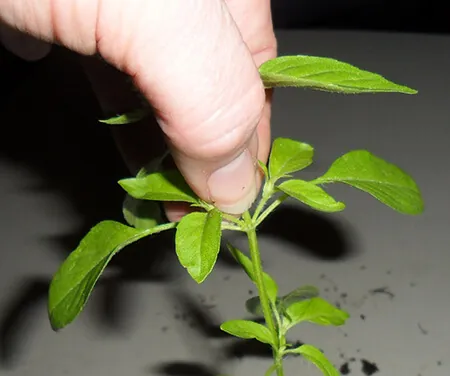
Image Credit: http://backyardpatch.blogspot.com/2013/05/pinch-your-herbs.html
122. Prune Regularly
Aside from aesthetics reasons, pruning also helps promote growth of new branches. So prune regularly and use a proper pruner. You run the risk of having plant disease if you don’t prune properly. GardenWare stocks some really high-quality pruners.

123. Avoid Moving Your Plants Too Much
Plants need time to adjust to their surroundings so avoid moving them too much. Moving your plants too much can cause them to get stressed and eventually die out.
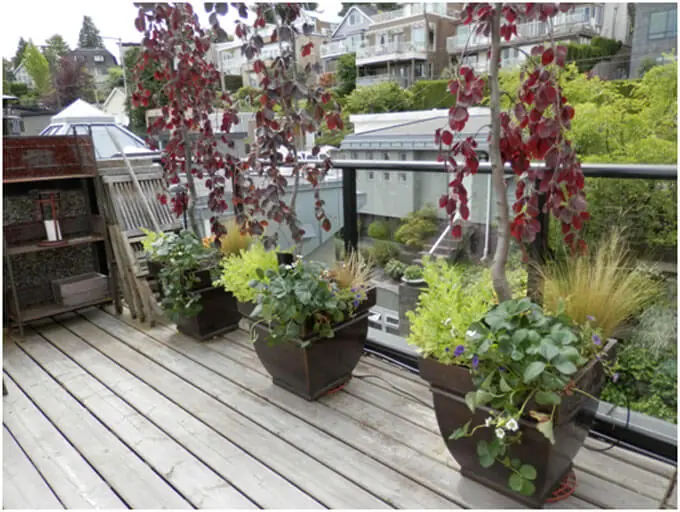
Image Credit: http://kathrynwilking.com/services/staging-and-redesign/
124. Bring Out the Artist in You; Paint Those Planters
If you’re feeling some artistic inspiration, try painting those pots. You can dull paint plastic pots and turn them into something eye-catching. You can even paint terra cotta pots but this will require some prep work. You have to make sure the terra cotta pots are clean before painting them. For an extra smooth finish, we would recommend sanding them first.
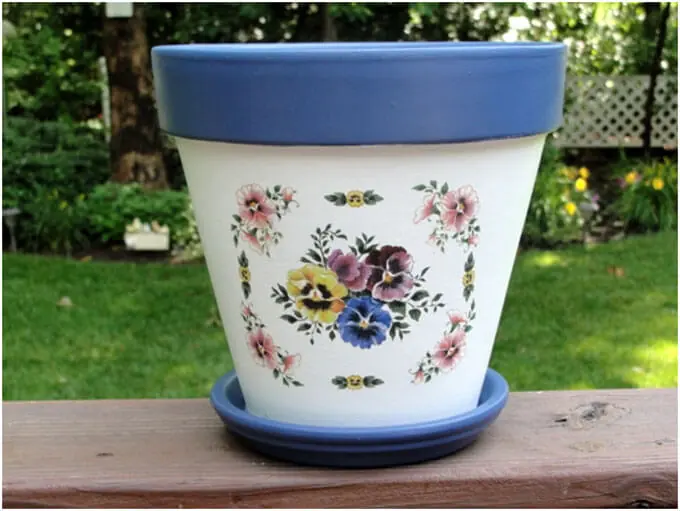
Image Credit: http://paintedseasons.com/flowerpots.html
125. Enjoy Gardening
All these tips will be for naught if you don’t really enjoy gardening. Gardening should be a fun activity so enjoy and have fun. Garden with a smile on your face.
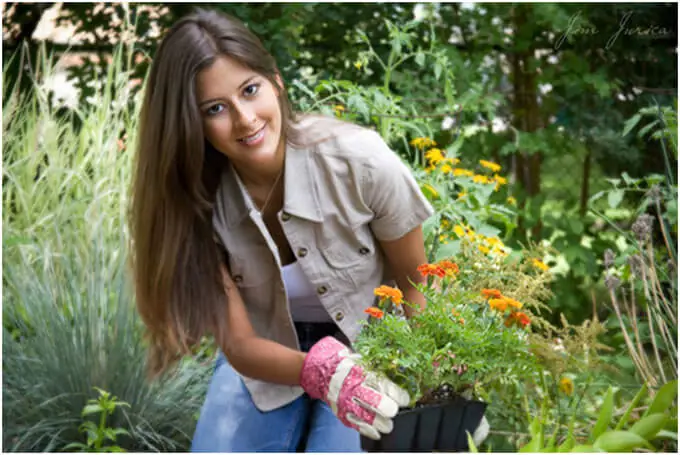



I love most of these ideas. Thanks for sharing. Would be nice if the names of plants were given. Also, I am curious about planting in wine barrels. All the tomatoes and bell peppers in our wine barrels didn’t make it.
This was so helpful thank you so much😊
Great ideas! I’m excited to get started 😄😊